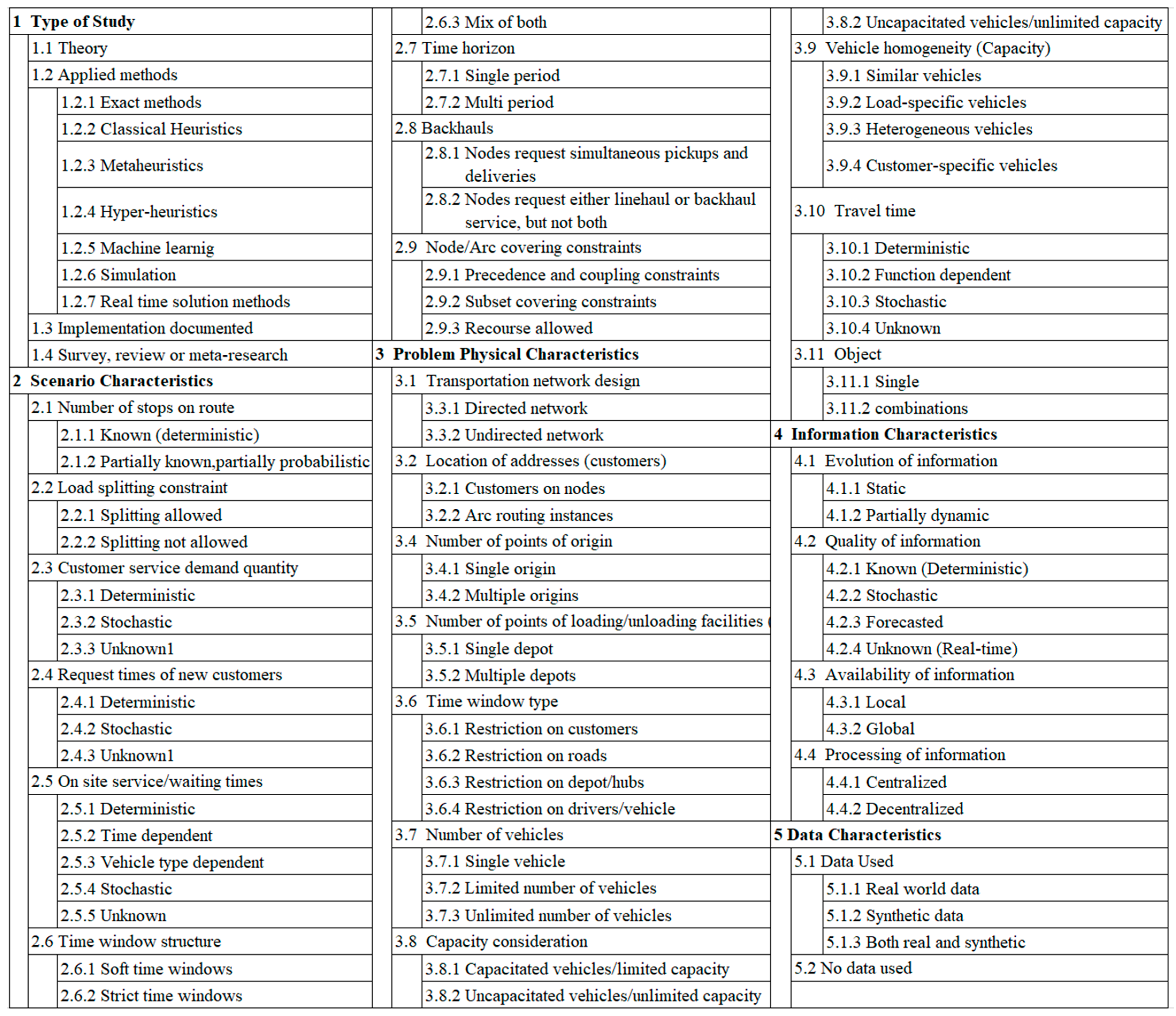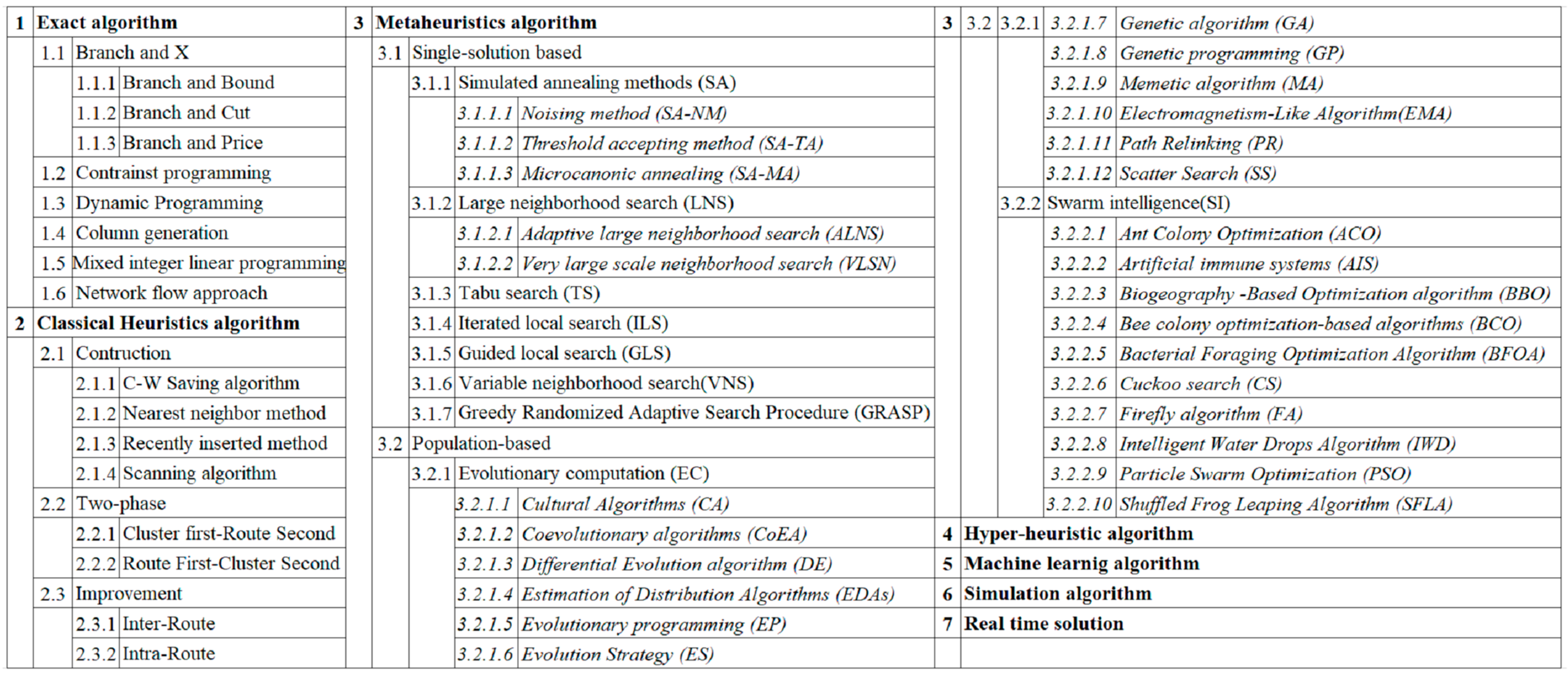A Bibliometric Visualized Analysis and Classification of Vehicle Routing Problem Research
Abstract
1. Introduction
2. Data and Methods
2.1. Data Acquisition
2.2. Scientometric Analytical Methods
3. Results
3.1. Basic Characteristics of the Bibliometric
3.1.1. Temporal Evolution of Publications and Citations
3.1.2. Research Area and Journal Source
3.1.3. Geographic Distribution of Publications
3.2. Collaboration Network Analysis of Bibliometric
3.2.1. Author Collaboration Network
3.2.2. Country Collaboration Network
3.2.3. Institutional Collaboration Network
3.3. Research Base, Hotspots, and Frontiers
3.3.1. Document Co-Citation Network Analysis
3.3.2. Keywords Co-Occurrence Network Analysis
4. Discussion
4.1. VRP Model and Its Variations
4.1.1. Taxonomy of VRP Model
4.1.2. VRP Variants
4.2. Solutions for VRP
4.2.1. Exact Algorithms
4.2.2. Classical Heuristic Algorithms
4.2.3. Metaheuristic Algorithms
4.2.4. Hyper-Heuristic Algorithms
4.2.5. Machine Learning
5. Conclusions
Author Contributions
Funding
Institutional Review Board Statement
Informed Consent Statement
Data Availability Statement
Acknowledgments
Conflicts of Interest
References
- Dantzig, G.B.; Ramser, J.H. The Truck Dispatching Problem. Manag. Sci. 1959, 6, 80–91. [Google Scholar] [CrossRef]
- Moghaddam, B.F.; Ruiz, R.; Sadjadi, S.J. Vehicle Routing Problem with Uncertain Demands: An advanced particle swarm algorithm. Comput. Ind. Eng. 2012, 62, 306–317. [Google Scholar] [CrossRef]
- Pillac, V.; Gendreau, M.; Gueret, C.; Medaglia, A.L. A review of dynamic vehicle routing problems. Eur. J. Oper. Res. 2013, 225, 1–11. [Google Scholar] [CrossRef]
- Soeffker, N.; Ulmer, M.W.; Mattfeld, D.C. Stochastic dynamic vehicle routing in the light of prescriptive analytics: A review. Eur. J. Oper. Res. 2022, 298, 801–820. [Google Scholar] [CrossRef]
- Erdoğan, S.; Miller-Hooks, E. A Green Vehicle Routing Problem. Transp. Res. Part E Logist. Transp. Rev. 2012, 48, 100–114. [Google Scholar] [CrossRef]
- Asghari, M.; Al-e-hashem, S. Green vehicle routing problem: A state-of-the-art review. Int. J. Prod. Econ. 2021, 231, 107899. [Google Scholar] [CrossRef]
- Moghdani, R.; Salimifard, K.; Demir, E.; Benyettou, A. The green vehicle routing problem: A systematic literature review. J. Clean. Prod. 2021, 279, 123691. [Google Scholar] [CrossRef]
- Barma, P.S.; Dutta, J.; Mukherjee, A.; Kar, S. A bi-objective latency based vehicle routing problem using hybrid GRASP-NSGAII algorithm. Int. J. Manag. Sci. Eng. Manag. 2022, 76168. [Google Scholar] [CrossRef]
- Dutta, J.; Barma, P.S.; Mukherjee, A.; Kar, S.; De, T. A hybrid multi-objective evolutionary algorithm for open vehicle routing problem through cluster primary-route secondary approach. Int. J. Manag. Sci. Eng. Manag. 2022, 17, 132–146. [Google Scholar] [CrossRef]
- Lin, B.; Ghaddar, B.; Nathwani, J. Deep Reinforcement Learning for the Electric Vehicle Routing Problem with Time Windows. Ieee Trans. Intell. Transp. Syst. 2022, 23, 11528–11538. [Google Scholar] [CrossRef]
- Joe, W.; Lau, H.C. Deep Reinforcement Learning Approach to Solve Dynamic Vehicle Routing Problem with Stochastic Customers. In Proceedings of the International Conference on Automated Planning and Scheduling, Nancy, France, 14–19 June 2020. [Google Scholar]
- Li, J.W.; Ma, Y.N.; Gao, R.Z.; Cao, Z.G.; Lim, A.; Song, W.; Zhang, J. Deep Reinforcement Learning for Solving the Heterogeneous Capacitated Vehicle Routing Problem. IEEE Trans. Cybern. 2022, 52, 14. [Google Scholar] [CrossRef]
- Czuba, P.; Pierzchala, D. Machine Learning methods for solving Vehicle Routing Problems. In Proceedings of the 36th International Business Information Management Association (IBIMA), Granada, Spain, 4–5 November 2021. [Google Scholar]
- Rodríguez-Esparza, E.; Masegosa, A.; Oliva, D.; Onieva, E. A new Hyper-heuristic based on Adaptive Simulated Annealing and Reinforcement Learning for the Capacitated Electric Vehicle Routing Problem. arXiv 2022, arXiv:abs/2206.03185. [Google Scholar] [CrossRef]
- Karimi-Mamaghan, M.; Mohammadi, M.; Meyer, P.; Karimi-Mamaghan, A.M.; Talbi, E.-G. Machine learning at the service of meta-heuristics for solving combinatorial optimization problems: A state-of-the-art. Eur. J. Oper. Res. 2022, 296, 393–422. [Google Scholar] [CrossRef]
- Golden, B.L. Vehicle Routing Problems and Variants. Am. J. Math. Manag. Sci. 1993, 13, 245–248. [Google Scholar] [CrossRef]
- Gendreau, M.; Ghiani, G.; Guerriero, E. Time-dependent routing problems: A review. Comput. Oper. Res. 2015, 64, 189–197. [Google Scholar] [CrossRef]
- Schiffer, M.; Schneider, M.; Walther, G.; Laporte, G. Vehicle Routing and Location Routing with Intermediate Stops: A Review. Transp. Sci. 2019, 53, 319–343. [Google Scholar] [CrossRef]
- Tan, S.Y.; Yeh, W.C. The Vehicle Routing Problem: State-of-the-Art Classification and Review. Appl. Sci. 2021, 11, 10295. [Google Scholar] [CrossRef]
- Li, B.J.; Wu, G.H.; He, Y.M.; Fan, M.F.; Pedrycz, W. An Overview and Experimental Study of Learning-Based Optimization Algorithms for the Vehicle Routing Problem. IEEE-CAA J. Autom. Sin. 2022, 9, 1115–1138. [Google Scholar] [CrossRef]
- Zhang, H.F.; Ge, H.W.; Yang, J.L.; Tong, Y.B. Review of Vehicle Routing Problems: Models, Classification and Solving Algorithms. Arch. Comput. Method Eng. 2022, 29, 195–221. [Google Scholar] [CrossRef]
- Rashid, H.F. Bibliometric Analysis as a Tool in Journal Evaluation. Ser. Libr. 1991, 20, 55–64. [Google Scholar] [CrossRef]
- Chen, C. Science Mapping: A Systematic Review of the Literature. J. Data Inf. Sci. 2017, 2, 1–40. [Google Scholar]
- Waltman, E.L. Software survey: VOSviewer, a computer program for bibliometric mapping. Scientometrics 2010, 84, 523–538. [Google Scholar]
- Chen, C. CiteSpace II: Detecting and visualizing emerging trends and transient patterns in scientific literature. J. Am. Soc. Inf. Sci. Technol. 2006, 57, 359–377. [Google Scholar] [CrossRef]
- Chen, C.; Hu, Z.; Liu, S.; Tseng, H. Emerging trends in regenerative medicine: A scientometric analysis in CiteSpace. Expert Opin Biol 2012, 12, 593–608. [Google Scholar] [CrossRef]
- Egghe, L. Theory and practise of the g-index. Scientometrics 2006, 69, 131–152. [Google Scholar] [CrossRef]
- Small, H. Co-Citation in the Scientific Literature: A New Measure of the Relationship Between Two Documents. J. Am. Soc. Inf. Sci. 1973, 24, 265–269. [Google Scholar] [CrossRef]
- Freeman, L.C. Centrality in social networks: Conceptual clarification. Soc. Netw. 1979, 1, 215–239. [Google Scholar] [CrossRef]
- Garfield, E.G. Research fronts. Curr. Contents 1994, 41, 3–7. [Google Scholar]
- Braekers, K.; Ramaekers, K.; Nieuwenhuyse, I.V. The vehicle routing problem: State of the art classification and review. Comput. Ind. Eng. 2016, 99, 300–313. [Google Scholar] [CrossRef]
- Toth, P.; Vigo, D. Vehicle Routing: Problems, Methods, and Applications, 2nd ed.; Society for Industrial and Applied Mathematics: Philadelphia, PA, USA, 2014. [Google Scholar]
- Agatz, N.; Bouman, P.; Schmidt, M. Optimization Approaches for the Traveling Salesman Problem with Drone. Transp. Sci. 2018, 52, 965–981. [Google Scholar] [CrossRef]
- Dorling, K.; Heinrichs, J.; Messier, G.G.; Magierowski, S. Vehicle Routing Problems for Drone Delivery. IEEE Trans. Syst. Man Cybern. Syst. 2017, 47, 70–85. [Google Scholar] [CrossRef]
- Wang, X.; Poikonen, S.; Golden, B. The vehicle routing problem with drones: Several worst-case results. Optim. Lett. 2017, 11, 679–697. [Google Scholar] [CrossRef]
- Montoya, A.; Guéret, C.; Mendoza, J.E.; Villegas, J.G. The electric vehicle routing problem with nonlinear charging function. Transp. Res. Part B: Methodol. 2017, 103, 87–110. [Google Scholar] [CrossRef]
- Hiermann, G.; Puchinger, J.; Ropke, S.; Hartl, R.F. The Electric Fleet Size and Mix Vehicle Routing Problem with Time Windows and Recharging Stations. Eur. J. Oper. Res. 2016, 252, 995–1018. [Google Scholar] [CrossRef]
- Schneider, M.; Stenger, A.; Goeke, D. The Electric Vehicle-Routing Problem with Time Windows and Recharging Stations. Transp. Sci. 2014, 48, 500–520. [Google Scholar] [CrossRef]
- Desaulniers, G.; Errico, F.; Irnich, S.; Schneider, M. Exact Algorithms for Electric Vehicle-Routing Problems with Time Windows. Oper. Res. 2016, 64, 1388–1405. [Google Scholar] [CrossRef]
- Lin, C.H.; Choy, K.L.; Ho, G.T.S.; Chung, S.H.; Lam, H.Y. Survey of Green Vehicle Routing Problem: Past and future trends. Expert Syst. Appl. 2014, 41, 1118–1138. [Google Scholar] [CrossRef]
- Chen, B.; Shin, S. Bibliometric Analysis on Research Trend of Accidental Falls in Older Adults by Using Citespace—Focused on Web of Science Core Collection (2010–2020). Int. J. Environ. Res. Public Health 2021, 18, 1663. [Google Scholar] [CrossRef]
- Azam, A.; Ahmed, A.; Wang, H.; Wang, Y.; Zhang, Z. Knowledge structure and research progress in wind power generation (WPG) from 2005 to 2020 using CiteSpace based scientometric analysis. J. Clean. Prod. 2021, 295, 126496. [Google Scholar] [CrossRef]
- Zhong, D.; Luo, S.; Zheng, L.; Zhang, Y.; Jin, R. Epilepsy Occurrence and Circadian Rhythm: A Bibliometrics Study and Visualization Analysis via CiteSpace. Front. Neurol. 2020, 11, 984. [Google Scholar] [CrossRef]
- Chen, C.; Song, M. Visualizing a field of research: A methodology of systematic scientometric reviews. PLoS ONE 2019, 14, e0223994. [Google Scholar] [CrossRef]
- Meng, L.; Wen, K.-H.; Brewin, R.; Wu, Q. Knowledge Atlas on the Relationship between Urban Street Space and Residents’ Health—A Bibliometric Analysis Based on VOSviewer and CiteSpace. Sustainability 2020, 12, 2384. [Google Scholar] [CrossRef]
- Hongqiang, M.; Hongyu, C.; Jinliang, H.; Jieya, G.; Wei, L. CiteSpace-based visualization analysis on mappings of alkali-activated cementitious materials in the field of engineering research. Case Stud. Constr. Mater. 2020, 12, e00350. [Google Scholar] [CrossRef]
- Chen, J.; Meng, S.; Zhou, W. The exploration of fuzzy linguistic research: A scientometric review based on CiteSpace. J. Intell. Fuzzy Syst. 2019, 37, 3655–3669. [Google Scholar] [CrossRef]
- Clarke, G.; Wright, J.W. Scheduling of Vehicles from a Central Depot to a Number of Delivery Points. Oper. Res. 1964, 12, 568–581. [Google Scholar] [CrossRef]
- Reisman, B.A. Management Science Knowledge; Praeger: Westport, CT, USA, 1992. [Google Scholar]
- Bodin, L.D. A taxonomic structure for vehicle routing and scheduling problems. Comput. Urban Soc. 1975, 1, 11–29. [Google Scholar] [CrossRef]
- Desrochers, M.; Lenstra, J.K.; Savelsbergh, M. A classification scheme for vehicle routing and scheduling problems. Eur. J. Oper. Res. 1990, 46, 322–332. [Google Scholar] [CrossRef]
- Desrochers, M.; Jones, C.V.; Lenstra, J.K.; Savelsbergh, M.; Stougie, L. Towards a model and algorithm management system for vehicle routing and scheduling problems. Decis. Support Syst. 1999, 25, 109–133. [Google Scholar] [CrossRef]
- Psaraftis, H.N. Dynamic vehicle routing: Status and prospects. Ann. Oper. Res. 1995, 61, 143–164. [Google Scholar] [CrossRef]
- Eksioglu, B.; Vural, A.V.; Reisman, A. The vehicle routing problem: A taxonomic review. Comput. Ind. Eng. 2009, 57, 1472–1483. [Google Scholar] [CrossRef]
- Labbe, M.; Laporte, G.; Mercure, H. Capacitated Vehicle-Routing on Trees. Oper. Res. 1991, 39, 616–622. [Google Scholar] [CrossRef]
- Xiao, Y.Y.; Zhao, Q.H.; Kaku, I.; Xu, Y.C. Development of a fuel consumption optimization model for the capacitated vehicle routing problem. Comput. Oper. Res. 2012, 39, 1419–1431. [Google Scholar] [CrossRef]
- Toth, P.; Vigo, D. Models, relaxations and exact approaches for the capacitated vehicle routing problem. Discret Appl. Math. 2002, 123, 487–512. [Google Scholar] [CrossRef]
- Ropke, S.; Pisinger, D. A unified heuristic for a large class of Vehicle Routing Problems with Backhauls. Eur. J. Oper. Res. 2006, 171, 750–775. [Google Scholar] [CrossRef]
- Toth, P.; Vigo, D. An exact algorithm for the vehicle routing problem with backhauls. Transp. Sci. 1997, 31, 372–385. [Google Scholar] [CrossRef]
- Gajpal, Y.; Abad, P.L. Multi-ant colony system (MACS) for a vehicle routing problem with backhauls. Eur. J. Oper. Res. 2009, 196, 102–117. [Google Scholar] [CrossRef]
- Brar, G.S.; Saini, G. Milk Run Logistics: Literature Review and Directions. In Proceedings of the World Congress on Engineering, London, UK, 6–8 July 2011. [Google Scholar]
- Solomon, M.M. Algorithms for the Vehicle-Routing and Scheduling Problems with Time Window Constraints. Oper. Res. 1987, 35, 254–265. [Google Scholar] [CrossRef]
- Braysy, I.; Gendreau, M. Vehicle routing problem with time windows, part 1: Route construction and local search algorithms. Transp. Sci. 2005, 39, 104–118. [Google Scholar] [CrossRef]
- Desrochers, M.; Desrosiers, J.; Solomon, M. A New Optimization Algorithm for the Vehicle-Routing Problem with Time Windows. Oper. Res. 1992, 40, 342–354. [Google Scholar] [CrossRef]
- Cordeau, J.F.; Laporte, G.; Mercier, A. A unified tabu search heuristic for vehicle routing problems with time windows. J. Oper. Res. Soc. 2001, 52, 928–936. [Google Scholar] [CrossRef]
- Psaraftis, H.N.; Wen, M.; Kontovas, C.A. Dynamic Vehicle Routing Problems: Three Decades and Counting. Networks 2016, 67, 3–31. [Google Scholar] [CrossRef]
- Bertsimas, D.J.; Vanryzin, G. A Stochastic and Dynamic Vehicle-Routing Problem in the Euclidean Plane. Oper. Res. 1991, 39, 601–615. [Google Scholar] [CrossRef]
- Bertsimas, D.J.; Ryzin, G.v. Stochastic and Dynamic Vehicle Routing in the Euclidean Plane with Multiple Capacitated Vehicles. Oper. Res. 1993, 41, 60–76. [Google Scholar] [CrossRef]
- Montero, A.; Miranda-Bront, J.J.; Mendez-Diaz, I. An ILP-based local search procedure for the VRP with pickups and deliveries. Ann. Oper. Res. 2017, 259, 327–350. [Google Scholar] [CrossRef]
- Nagy, G.; Salhi, S. Heuristic algorithms for single and multiple depot Vehicle Routing Problems with Pickups and Deliveries. Eur. J. Oper. Res. 2005, 162, 126–141. [Google Scholar] [CrossRef]
- Mitra, S. A parallel clustering technique for the vehicle routing problem with split deliveries and pickups. J. Oper. Res. Soc. 2008, 59, 1532–1546. [Google Scholar] [CrossRef]
- Wassan, N.A.; Wassan, A.H.; Nagy, G. A reactive tabu search algorithm for the vehicle routing problem with simultaneous pickups and deliveries. J. Comb. Optim. 2008, 15, 368–386. [Google Scholar] [CrossRef]
- Liu, W.J.; Zhou, Y.T.; Liu, W.; Qiu, J.; Xie, N.M.; Chang, X.Y.; Chen, J. A hybrid ACS-VTM algorithm for the vehicle routing problem with simultaneous delivery & pickup and real-time traffic condition. Comput. Ind. Eng. 2021, 162, 107747. [Google Scholar] [CrossRef]
- Yu, V.F.; Aloina, G.; Jodiawan, P.; Gunawan, A.; Huang, T.-C. The vehicle routing problem with simultaneous pickup and delivery and occasional drivers. Expert Syst. Appl. 2023, 214, 119118. [Google Scholar] [CrossRef]
- Hosseini-Motlagh, S.-M.; Farahmand, M.; Nouri-Harzvili, M. A multi-path traffic-covering pollution routing model with simultaneous pickup and delivery. Comput. Ind. Eng. 2022, 173, 108644. [Google Scholar] [CrossRef]
- Dursun, O.O.; Ozger, A. Multi-depot heterogeneous fleet vehicle routing problem with time windows: Airline and roadway integrated routing. Int. J. Ind. Eng. Comput. 2022, 13, 435–456. [Google Scholar] [CrossRef]
- Zhang, Q.H.; Wang, Z.T.; Huang, M.; Yu, Y.; Fang, S.C. Heterogeneous multi-depot collaborative vehicle routing problem. Transp. Res. Part B Methodol. 2022, 160, 1–20. [Google Scholar] [CrossRef]
- Sahin, M.K.; Yamana, H. A Branch and Price Algorithm for the Heterogeneous Fleet Multi-Depot Multi-Trip Vehicle Routing Problem with Time Windows. Transp. Sci. 2022, 56, 1409–1722. [Google Scholar] [CrossRef]
- Anuar, W.K.; Lee, L.S.; Seow, H.V.; Pickl, S. A Multi-Depot Dynamic Vehicle Routing Problem with Stochastic Road Capacity: An MDP Model and Dynamic Policy for Post-Decision State Rollout Algorithm in Reinforcement Learning. Mathematics 2022, 10, 2699. [Google Scholar] [CrossRef]
- Zhou, L.; Baldacci, R.; Vigo, D.; Wang, X. A Multi-Depot Two-Echelon Vehicle Routing Problem with Delivery Options Arising in the Last Mile Distribution. Eur. J. Oper. Res. 2018, 265, 765–778. [Google Scholar] [CrossRef]
- Tadaros, M.; Migdalas, A.; Samuelsson, B. A note on the hierarchical multi-switch multi-echelon vehicle routing problem. Optim. Lett. 2022. [Google Scholar] [CrossRef]
- Chen, H.K.; Hsueh, C.F.; Chang, M.S. The real-time time-dependent vehicle routing problem. Transp. Res. Part E Logist. Transp. Rev. 2006, 42, 383–408. [Google Scholar] [CrossRef]
- Huang, Y.X.; Zhao, L.; Van Woensel, T.; Gross, J.P. Time-dependent vehicle routing problem with path flexibility. Transp. Res. Pt. B-Methodol. 2017, 95, 169–195. [Google Scholar] [CrossRef]
- Franceschetti, A.; Honhon, D.; Van Woensel, T.; Bektaş, T.; Laporte, G. The time-dependent pollution-routing problem. Transp. Res. Part B Methodol. 2013, 56, 265–293. [Google Scholar] [CrossRef]
- Dror, M.; Trudeau, P. Savings by Split Delivery Routing. Transp. Sci. 1989, 23, 141–145. [Google Scholar] [CrossRef]
- Archetti, C.; Speranza, M.G.; Hertz, A. A tabu search algorithm for the split delivery vehicle routing problem. Transp. Sci. 2006, 40, 64–73. [Google Scholar] [CrossRef]
- Bortfeldt, A.; Yi, J.M. The Split Delivery Vehicle Routing Problem with three-dimensional loading constraints. Eur. J. Oper. Res. 2020, 282, 545–558. [Google Scholar] [CrossRef]
- Wu, D.Q.; Wu, C.X. Research on the Time-Dependent Split Delivery Green Vehicle Routing Problem for Fresh Agricultural Products with Multiple Time Windows. Agriculture 2022, 12, 793. [Google Scholar] [CrossRef]
- Bertazzi, L.; Wang, X.Y. Matheuristics with performance guarantee for the unsplit and split delivery capacitated vehicle routing problem. Networks 2022, 80, 482–501. [Google Scholar] [CrossRef]
- Bektaş, T.; Laporte, G. The Pollution-Routing Problem. Transp. Res. Part B Methodol. 2011, 45, 1232–1250. [Google Scholar] [CrossRef]
- Sabet, S.; Farooq, B. Green Vehicle Routing Problem: State of the Art and Future Directions. IEEE Access 2022, 10, 101622–101642. [Google Scholar] [CrossRef]
- Zhou, Y.; Liu, C.; Xu, Q. Time-Dependent Green Location-Routing Problem under Carbon Cap-and-Trade Policy. Transp. Res. Rec. 2022, OnlinFirst. [Google Scholar] [CrossRef]
- Ferreira, J.C.; Steiner, M.T.A.; Canciglieri Junior, O. Multi-objective optimization for the green vehicle routing problem: A systematic literature review and future directions. Cogent Eng. 2020, 7, 1807082. [Google Scholar] [CrossRef]
- Qin, G.; Tao, F.; Li, L.; Chen, Z. Optimization of the simultaneous pickup and delivery vehicle routing problem based on carbon tax. Ind. Manag. Data Syst. 2019, 119, 2055–2071. [Google Scholar] [CrossRef]
- Liu, G.K.; Hu, J.Y.; Yang, Y.; Xia, S.M.; Lim, M.K. Vehicle routing problem in cold Chain logistics: A joint distribution model with carbon trading mechanisms. Resour. Conserv. Recycl. 2020, 156, 104715. [Google Scholar] [CrossRef]
- Zhou, B.H.; Zhao, Z. Multi-objective optimization of electric vehicle routing problem with battery swap and mixed time windows. Neural Comput. Appl. 2022, 34, 7325–7348. [Google Scholar] [CrossRef]
- Demir, E.; Bektaş, T.; Laporte, G. A review of recent research on green road freight transportation. Eur. J. Oper. Res. 2014, 237, 775–793. [Google Scholar] [CrossRef]
- Pelletier, S.; Jabali, O.; Laporte, G.; Veneroni, M. Battery degradation and behaviour for electric vehicles: Review and numerical analyses of several models. Transp. Res. Part B Methodol. 2017, 103, 158–187. [Google Scholar] [CrossRef]
- Schrage, L. Formulation and structure of more complex/realistic routing and scheduling problems. Networks 1981, 11, 229–232. [Google Scholar] [CrossRef]
- Ozcetin, E.; Ozturk, G. A variable neighborhood search for Open Vehicle Routing Problem. Concurr. Comput.-Pract. Exp. 2022, 13, e7598. [Google Scholar] [CrossRef]
- Lopez-Sanchez, A.D.; Hernandez-Diaz, A.G.; Vigo, D.; Caballero, R.; Molina, J. A multi-start algorithm for a balanced real-world Open Vehicle Routing Problem. Eur. J. Oper. Res. 2014, 238, 104–113. [Google Scholar] [CrossRef]
- Salari, M.; Toth, P.; Tramontani, A. An ILP improvement procedure for the Open Vehicle Routing Problem. Comput. Oper. Res. 2010, 37, 2106–2120. [Google Scholar] [CrossRef]
- Moutaoukil, A.; Neubert, G.; Derrouiche, R. A Comparison of Homogeneous and Heterogeneous Vehicle Fleet Size in Green Vehicle Routing Problem. In Proceedings of the IFIP WG 5.7 International Conference on Advances in Production Management Systems (APSM), Ajaccio, France, 20–24 September 2014; pp. 450–457. [Google Scholar]
- Leggieri, V.; Haouari, M. Lifted polynomial size formulations for the homogeneous and heterogeneous vehicle routing problems. Eur. J. Oper. Res. 2017, 263, 755–767. [Google Scholar] [CrossRef]
- Gendreau, M.; Laporte, G.; Musaraganyi, C.; Taillard, E.D. A tabu search heuristic for the heterogeneous fleet vehicle routing problem. Comput. Oper. Res. 1999, 26, 1153–1173. [Google Scholar] [CrossRef]
- Lima, C.M.R.R.; Goldbarg, M.C.; Goldbarg, E.F.G. A Memetic Algorithm for the Heterogeneous Fleet Vehicle Routing Problem. Electron. Notes Discret. Math. 2004, 18, 171–176. [Google Scholar] [CrossRef]
- Penna, P.H.V.; Subramanian, A.; Ochi, L.S. An Iterated Local Search heuristic for the Heterogeneous Fleet Vehicle Routing Problem. J. Heuristics 2013, 19, 201–232. [Google Scholar] [CrossRef]
- Gendreau, M.; Iori, M.; Laporte, G.; Martello, S. A Tabu Search heuristic for the vehicle routing problem with two-dimensional loading constraints. Networks 2008, 51, 4–18. [Google Scholar] [CrossRef]
- Wei, L.J.; Zhang, Z.Z.; Zhang, D.F.; Leung, S.C.H. A simulated annealing algorithm for the capacitated vehicle routing problem with two-dimensional loading constraints. Eur. J. Oper. Res. 2018, 265, 843–859. [Google Scholar] [CrossRef]
- Zhang, X.Y.; Chen, L.; Gendreau, M.; Langevin, A. A branch-and-cut algorithm for the vehicle routing problem with two-dimensional loading constraints. Eur. J. Oper. Res. 2022, 302, 259–269. [Google Scholar] [CrossRef]
- Tarantilis, C.D.; Zachariadis, E.E.; Kiranoudis, C.T. A Hybrid Metaheuristic Algorithm for the Integrated Vehicle Routing and Three-Dimensional Container-Loading Problem. Ieee Trans. Intell. Transp. Syst. 2009, 10, 255–271. [Google Scholar] [CrossRef]
- Wei, L.J.; Zhang, Z.Z.; Lim, A. An Adaptive Variable Neighborhood Search for a Heterogeneous Fleet Vehicle Routing Problem with Three-Dimensional Loading Constraints. IEEE Comput. Intell. Mag. 2014, 9, 18–30. [Google Scholar] [CrossRef]
- Zhang, Z.Z.; Wei, L.J.; Lim, A. An evolutionary local search for the capacitated vehicle routing problem minimizing fuel consumption under three-dimensional loading constraints. Transp. Res. Part B Methodol. 2015, 82, 20–35. [Google Scholar] [CrossRef]
- Wang, Y.; Li, Q.; Guan, X.Y.; Xu, M.Z.; Liu, Y.; Wang, H.Z. Two-echelon collaborative multi-depot multi-period vehicle routing problem. Expert Syst. Appl. 2021, 167, 10–1016. [Google Scholar] [CrossRef]
- Xu, G.C.; Lyu, Q.G. Vehicle Routing Problem for Collaborative Multidepot Petrol Replenishment under Emergency Conditions. J. Adv. Transp. 2021, 2021, 5531500. [Google Scholar] [CrossRef]
- Konstantakopoulos, G.D.; Gayialis, S.P.; Kechagias, E.P. Vehicle routing problem and related algorithms for logistics distribution: A literature review and classification. Oper. Res. 2022, 22, 2033–2062. [Google Scholar] [CrossRef]
- Chinh, N.Q.; Kim, H.C.; Jiang, S.W.; Zhang, N.S. Collaborative Vehicle Routing Problem for Urban Last-mile Logistics. In Proceedings of the IEEE International Conference on Systems, Man, and Cybernetics (SMC), Budapest, Hungary, 9–12 October 2016; pp. 1531–1536. [Google Scholar]
- MacLachlan, J.; Mei, Y.; Branke, J.; Zhang, M.J. Genetic Programming Hyper-Heuristics with Vehicle Collaboration for Uncertain Capacitated Arc Routing Problems. Evol. Comput. 2020, 28, 563–593. [Google Scholar] [CrossRef] [PubMed]
- Mancini, S.; Gansterer, M.; Hartl, R.F. The collaborative consistent vehicle routing problem with workload balance. Eur. J. Oper. Res. 2021, 293, 955–965. [Google Scholar] [CrossRef]
- Vahedi-Nouri, B.; Arbabi, H.; Jolai, F.; Tavakkoli-Moghaddam, R.; Bozorgi-Amiri, A. Bi-objective collaborative electric vehicle routing problem: Mathematical modeling and matheuristic approach. J. Ambient Intell. Humaniz. Comput. 2022, 1–21. [Google Scholar] [CrossRef]
- Wang, Y.; Ran, L.Y.; Guan, X.Y.; Fan, J.X.; Sun, Y.Y.; Wang, H.Z. Collaborative multicenter vehicle routing problem with time windows and mixed deliveries and pickups. Expert Syst. Appl. 2022, 197, 116690. [Google Scholar] [CrossRef]
- Groer, C.; Golden, B.; Wasil, E. The Consistent Vehicle Routing Problem. MSOM-Manuf. Serv. Oper. Manag. 2009, 11, 630–643. [Google Scholar] [CrossRef]
- Tarantilis, C.D.; Stavropoulou, F.; Repoussis, P.P. A template-based Tabu Search algorithm for the Consistent Vehicle Routing Problem. Expert Syst. Appl. 2012, 39, 4233–4239. [Google Scholar] [CrossRef]
- Yang, M.; Ni, Y.D.; Yang, X.F.; Ralescu, D.A. The consistent vehicle routing problem under uncertain environment. J. Intell. Fuzzy Syst. 2021, 41, 2797–2812. [Google Scholar] [CrossRef]
- Beltrami, E.J.; Bodin, L.D. Networks and vehicle routing for municipal waste collection. Networks 1974, 4, 65–94. [Google Scholar] [CrossRef]
- Vega-Figueroa, S.E.; Lopez-Becerra, P.A.; Lopez-Santana, E.R. Hybrid algorithm for the solution of the periodic vehicle routing problem with variable service frequency. Int. J. Ind. Eng. Comput. 2022, 13, 277–292. [Google Scholar] [CrossRef]
- Huerta-Munoz, D.L.; Archetti, C.; Fernandez, E.; Perea, F. The Heterogeneous Flexible Periodic Vehicle Routing Problem: Mathematical formulations and solution algorithms. Comput. Oper. Res. 2022, 141, 105662. [Google Scholar] [CrossRef]
- Chao, I.M. A tabu search method for the truck and trailer routing problem. Comput. Oper. Res. 2002, 29, 33–51. [Google Scholar] [CrossRef]
- Scheuerer, S. A tabu search heuristic for the truck and trailer routing problem. Comput. Oper. Res. 2006, 33, 894–909. [Google Scholar] [CrossRef]
- Li, T.; Yang, W.Y.; Wang, L.; Cai, C.; Liang, K.K. Research on Site Selection of Logistics Nodes in Expressway Service Area Considering Truck and Trailer Vehicle Routing Problem. In Proceedings of the 19th COTA International Conference of Transportation Professionals (CICTP)—Transportation in China 2025, Nanjing, China, 6–8 July 2019; pp. 4938–4949. [Google Scholar]
- Villegas, J.G.; Prins, C.; Prodhon, C.; Medaglia, A.L.; Velasco, N. A GRASP with evolutionary path relinking for the truck and trailer routing problem. Comput. Oper. Res. 2011, 38, 1319–1334. [Google Scholar] [CrossRef]
- Van Breedam, A. Comparing descent heuristics and metaheuristics for the vehicle routing problem. Comput. Oper. Res. 2001, 28, 289–315. [Google Scholar] [CrossRef]
- Prodhon, C.; Prins, C. Metaheuristics for Vehicle Routing Problems. In Metaheuristics, Siarry, P., Ed.; Springer International Publishing: Cham, Switzerland, 2016; pp. 407–437. [Google Scholar]
- Blocho, M. Chapter 4—Heuristics, metaheuristics, and hyperheuristics for rich vehicle routing problems. In Smart Delivery Systems, Nalepa, J., Ed.; Elsevier: Amsterdam, The Netherlands, 2020; pp. 101–156. [Google Scholar]
- Chakhlevitch, K.; Cowling, P. Hyperheuristics: Recent Developments. In Adaptive and Multilevel Metaheuristics; Cotta, C., Sevaux, M., Sörensen, K., Eds.; Springer: Berlin/Heidelberg, Germany, 2008; pp. 3–29. [Google Scholar]
- Burke, E.K.; Hyde, M.; Kendall, G.; Ochoa, G.; Özcan, E.; Woodward, J.R. A Classification of Hyper-heuristic Approaches. In Handbook of Metaheuristics; Gendreau, M., Potvin, J.-Y., Eds.; Springer: Boston, MA, USA, 2010; pp. 449–468. [Google Scholar]
- Labadie, N.; Prins, C.; Prodhon, C. Metaheuristics for Vehicle Routing Problems; Wiley: Hoboken, NJ, USA, 2016. [Google Scholar]
- Goel, R.K.; Maini, R. Vehicle routing problem and its solution methodologies: A survey. Int. J. Logist. Syst. Manag. 2017, 28, 419–435. [Google Scholar] [CrossRef]
- Laporte, G. Fifty Years of Vehicle Routing. Transp. Sci. 2009, 43, 408–416. [Google Scholar] [CrossRef]
- Lin, S. Computer solutions of the traveling salesman problem. Bell Labs Tech. J. 1965, 44, 2245–2269. [Google Scholar] [CrossRef]
- Glover, F. Future paths for integer programming and links to artificial intelligence. Comput. Oper. Res. 1986, 13, 533–549. [Google Scholar] [CrossRef]
- Kirkpatrick, S.; Gelatt, C.D.; Vecchi, M.P. Optimization by Simulated Annealing. Science 1983, 220, 671–680. [Google Scholar] [CrossRef] [PubMed]
- Elshaer, R.; Awad, H. A taxonomic review of metaheuristic algorithms for solving the vehicle routing problem and its variants. Comput. Ind. Eng. 2020, 140, 106242. [Google Scholar] [CrossRef]
- Balinski, M.L.; Quandt, R.E. On An Integer Program for a Delivery Problem. Oper. Res. 1964, 12, 300–304. [Google Scholar] [CrossRef]
- Eilon, S.; Watson-Gandy, C.D.T.; Christofides, N.; Neufville, R.d. Distribution Management-Mathematical Modelling and Practical Analysis. IEEE Trans. Syst. Man Cybern. 1974, SMC-4, 589-589. [Google Scholar] [CrossRef]
- Christofides, N.; Mingozzi, A.; Toth, P. The vehicle routing problem. Comb. Optim. 1979, 2, 315–338. [Google Scholar] [CrossRef]
- Laporte, G.; Nobert, Y.; Desrochers, M. Optimal Routing under Capacity and Distance Restrictions. Oper. Res. 1985, 33, 1050–1073. [Google Scholar] [CrossRef]
- Lawler, E.L.; Wood, D.E. Branch-and-Bound Methods: A Survey. Oper. Res. 1966, 14, 699–719. [Google Scholar] [CrossRef]
- Pecin, D.; Contardo, C.; Desaulniers, G.; Uchoa, E. New Enhancements for the Exact Solution of the Vehicle Routing Problem with Time Windows. Inf. J. Comput. 2017, 29, 489–502. [Google Scholar] [CrossRef]
- Costa, L.; Contardo, C.; Desaulniers, G. Exact Branch-Price-and-Cut Algorithms for Vehicle Routing. Transp. Sci. 2019, 53, 946–985. [Google Scholar] [CrossRef]
- Lysgaard, J.; Letchford, A.N.; Eglese, R.W. A new branch-and-cut algorithm for the capacitated vehicle routing problem. Math. Program. 2004, 100, 423–445. [Google Scholar] [CrossRef]
- Achuthan, N.R.; Caccetta, L.; Hill, S.P. An improved branch-and-cut algorithm for the capacitated vehicle routing problem. Transp. Sci. 2003, 37, 153–169. [Google Scholar] [CrossRef]
- Xie, Y.; Lu, W.; Wang, W.; Quadrifoglio, L. A multimodal location and routing model for hazardous materials transportation. J. Hazard. Mater. 2012, 227–228, 135–141. [Google Scholar] [CrossRef] [PubMed]
- Pasha, J.; Nwodu, A.L.; Fathollahi-Fard, A.M.; Tian, G.D.; Li, Z.W.; Wang, H.; Dulebenets, M.A. Exact and metaheuristic algorithms for the vehicle routing problem with a factory-in-a-box in multi-objective settings. Adv. Eng. Inform. 2022, 52, 19. [Google Scholar] [CrossRef]
- Dasdemir, E.; Guleryuz, G.; Testik, M.C.; Ozturk, D.T.; Sakar, C.T.; Testik, O.M. A multi-objective open vehicle routing problem with overbooking: Exact and heuristic solution approaches for an employee transportation problem. Omega-Int. J. Manag. Sci. 2022, 108, 102587. [Google Scholar] [CrossRef]
- Kheiri, A.; Ahmed, L.; Boyaci, B.; Gromicho, J.; Mumford, C.; Ozcan, E.; Dirikoc, A.S. Exact and hyper-heuristic solutions for the distribution-installation problem from the VeRoLog 2019 challenge. Networks 2020, 76, 294–319. [Google Scholar] [CrossRef]
- Gocmen, E.; Erol, R. Transportation problems for intermodal networks: Mathematical models, exact and heuristic algorithms, and machine learning. Expert Syst. Appl. 2019, 135, 374–387. [Google Scholar] [CrossRef]
- Pisinger, D.; Ropke, S. A general heuristic for vehicle routing problems. Comput. Oper. Res. 2007, 34, 2403–2435. [Google Scholar] [CrossRef]
- Vidal, T.; Crainic, T.G.; Gendreau, M.; Prins, C. Heuristics for multi-attribute vehicle routing problems: A survey and synthesis. Eur. J. Oper. Res. 2013, 231, 1–21. [Google Scholar] [CrossRef]
- Gillett, B.E.; Miller, L.R. A Heuristic Algorithm for the Vehicle-Dispatch Problem. Oper. Res. 1974, 22, 340–349. [Google Scholar] [CrossRef]
- Fisher, M.L.; Jaikumar, R. A generalized assignment heuristic for vehicle routing. Networks 1981, 11, 109–124. [Google Scholar] [CrossRef]
- Beasley, J.E. Route first—Cluster second methods for vehicle routing. Omega 1983, 11, 403–408. [Google Scholar] [CrossRef]
- Gendrau, M.; Laporte, G.; Potvin, J.Y. Vehicle routing:Modern Heuristics. In Local Search in Combinatorial Optimization; Aarts, E., Lenstra, J.K., Eds.; Wiley and Sons: Hoboken, NJ, USA, 1997; pp. 311–336. [Google Scholar]
- Cordeau, J.F.; Gendreau, M.; Laporte, G.; Potvin, J.Y.; Semet, F. A guide to vehicle routing heuristics. J. Oper. Res. Soc. 2017, 53, 512–522. [Google Scholar] [CrossRef]
- Blum, C.; Roli, A. Metaheuristics in combinatorial optimization: Overview and conceptual comparison. ACM Comput. Surv. 2003, 35, 268–308. [Google Scholar] [CrossRef]
- Boussaïd, I.; Lepagnot, J.; Siarry, P. A survey on optimization metaheuristics. Inf. Sci. 2013, 237, 82–117. [Google Scholar] [CrossRef]
- Glover, F. Tabu Search: A Tutorial. Interfaces 1990, 20, 74–94. [Google Scholar] [CrossRef]
- Kyriakakis, N.A.; Sevastopoulos, I.; Marinaki, M.; Marinakis, Y. A hybrid Tabu search—Variable neighborhood descent algorithm for the cumulative capacitated vehicle routing problem with time windows in humanitarian applications. Comput. Ind. Eng. 2022, 164, 107868. [Google Scholar] [CrossRef]
- Niranjani, G.; Umamaheswari, K. Minimization of Sustainable-Cost Using Tabu Search for Single Depot Heterogeneous Vehicle Routing Problem with Time Windows. Wirel. Pers. Commun. 2022, 126, 1481–1514. [Google Scholar] [CrossRef]
- Zhang, H.Z.; Zhang, K.; Chen, Y.T.; Ma, L. Multi-objective two-level medical facility location problem and tabu search algorithm. Inf. Sci. 2022, 608, 734–756. [Google Scholar] [CrossRef]
- Bogue, E.T.; Ferreira, H.S.; Noronha, T.F.; Prins, C. A column generation and a post optimization VNS heuristic for the vehicle routing problem with multiple time windows. Optim. Lett. 2022, 16, 79–95. [Google Scholar] [CrossRef]
- Machado, A.M.; Mauri, G.R.; Boeres, M.C.S.; Rosa, R.D. A new hybrid matheuristic of GRASP and VNS based on constructive heuristics, set-covering and set-partitioning formulations applied to the capacitated vehicle routing problem. Expert Syst. Appl. 2021, 184, 115556. [Google Scholar] [CrossRef]
- Dhahri, A.; Mjirda, A.; Zidi, K.; Ghedira, K. A VNS-based heuristic for solving the vehicle routing problem with time windows and vehicle preventive maintenance constraints. In Proceedings of the 16th Annual International Conference on Computational Science (ICCS), Univ Calif, San Diego Supercomputer Ctr. San Diego, CA, USA, 6-8 June 2016; pp. 1212–1222. [Google Scholar]
- Holland, J. Adaptation in Natural and artificial Systems: An Introductory Analysis with Application to Biology, Control and Artificial Intelligence; University of Michigan Press: Ann Arbor, MI, USA, 1975. [Google Scholar]
- Baker, B.M.; Ayechew, M.A. A genetic algorithm for the vehicle routing problem. Comput. Oper. Res. 2003, 30, 787–800. [Google Scholar] [CrossRef]
- May, A.T.; Jariyavajee, C.; Polvichai, J. An Improved Genetic Algorithm for Vehicle Routing Problem with Hard Time Windows. In Proceedings of the IEEE International Conference on Electrical, Computer, and Energy Technologies (ICECET), Cape Town, South Africa, 9–10 December 2021; pp. 1907–1912. [Google Scholar]
- Ngueveu, S.U.; Prins, C.; Calvo, R.W. An effective memetic algorithm for the cumulative capacitated vehicle routing problem. Comput. Oper. Res. 2010, 37, 1877–1885. [Google Scholar] [CrossRef]
- Berahhou, A.; Benadada, Y.; Bouanane, K. Memetic algorithm for the dynamic vehicle routing problem with simultaneous delivery and pickup. Int. J. Ind. Eng. Comput. 2022, 13, 587–600. [Google Scholar] [CrossRef]
- Nucamendi-Guillen, S.; Flores-Diaz, D.; Olivares-Benitez, E.; Mendoza, A. A Memetic Algorithm for the Cumulative Capacitated Vehicle Routing Problem Including Priority Indexes. Appl. Sci.-Basel 2020, 10, 3943. [Google Scholar] [CrossRef]
- Dorigo, M.; Maniezzo, V.; Colorni, A. Ant system: Optimization by a colony of cooperating agents. IEEE Trans. Syst. Man Cybern. Part B 1996, 26, 29–41. [Google Scholar] [CrossRef]
- Gad, A.G. Particle Swarm Optimization Algorithm and Its Applications: A Systematic Review. Arch. Comput. Method Eng. 2022, 29, 2531–2561. [Google Scholar] [CrossRef]
- Zhang, Y.; Wang, S.; Ji, G. A Comprehensive Survey on Particle Swarm Optimization Algorithm and Its Applications. Math. Probl. Eng. 2015, 2015, 931256. [Google Scholar] [CrossRef]
- Kennedy, J.; Eberhart, R. Particle swarm optimization. In Proceedings of the ICNN’95—International Conference on Neural Networks, Perth, WA, Australia, 27 November–1 December 1995; pp. 1942–1948. [Google Scholar]
- Burke, E.K.; Gendreau, M.; Hyde, M.; Kendall, G.; Ochoa, G.; Özcan, E.; Qu, R. Hyper-heuristics: A survey of the state of the art. J. Oper. Res. Soc. 2013, 64, 1695–1724. [Google Scholar] [CrossRef]
- Ortiz-Aguilar, L.; Carpio, M.; Rojas-Domínguez, A.; Ornelas-Rodriguez, M.; Puga-Soberanes, H.J.; Soria-Alcaraz, J.A. A Methodology to Determine the Subset of Heuristics for Hyperheuristics through Metalearning for Solving Graph Coloring and Capacitated Vehicle Routing Problems. Complexity 2021, 2021, 6660572. [Google Scholar] [CrossRef]
- Mlejnek, J.; Kubalik, J. Evolutionary hyperheuristic for capacitated vehicle routing problem. In Proceedings of the 15th annual conference companion on Genetic and evolutionary computation, Amsterdam, The Netherlands, 6–10 July 2013; pp. 219–220. [Google Scholar]
- Garrido, P.; Castro, C. Stable solving of CVRPs using hyperheuristics. In Proceedings of the 11th Annual conference on Genetic and evolutionary computation, Montreal, QC, Canada, 8–12 July 2009. [Google Scholar]
- Cowling, P.; Kendall, G.; Soubeiga, E. A Hyperheuristic Approach to Scheduling a Sales Summit. In Practice and Theory of Automated Timetabling; Springer: Berlin/Heidelberg, Germany, 2001; pp. 176–190. [Google Scholar]
- Cowling, P.; Kendall, G.; Soubeiga, E. Hyperheuristics: A Tool for Rapid Prototyping in Scheduling and Optimisation. In Applications of Evolutionary Computing; Springer: Berlin/Heidelberg, Germany, 2002; pp. 1–10. [Google Scholar]
- Burke, E.K.; Matthew, T.C.; Graham, H.; Gabriela, K.; Jos, P. HyFlex: A Flexible Framework for the Design and Analysis of Hyper-heuristics. In Proceedings of the Multidisciplinary International Scheduling Conference (MISTA 2009), Dublin, Ireland, 10–12 August 2009. [Google Scholar]
- Garrido, P.; Castro, C.; Monfroy, É. Towards a Flexible and Adaptable Hyperheuristic Approach for VRPs. In Proceedings of the International Conference on Artificial Intelligence, Las Vegas, NV, USA, 13–16 July 2009. [Google Scholar]
- Sim, K.; Hart, E. A Combined Generative and Selective Hyper-heuristic for the Vehicle Routing Problem. In Proceedings of the Genetic and Evolutionary Computation Conference 2016, Denver, Colorado, USA, 20–24 July 2016; pp. 1093–1100. [Google Scholar]
- Leng, L.; Zhang, J.; Zhang, C.; Zhao, Y.; Wang, W.; Li, G. Decomposition-based hyperheuristic approaches for the bi-objective cold chain considering environmental effects. Comput. Oper. Res. 2020, 123, 105043. [Google Scholar] [CrossRef]
- Kalatzantonakis, P.; Sifaleras, A.; Samaras, N. A reinforcement learning-Variable neighborhood search method for the capacitated Vehicle Routing Problem. Expert Syst. Appl. 2023, 213, 118812. [Google Scholar] [CrossRef]
- Bishop, C. Pattern Recognition and Machine Learning. Information Science and Statistics; Springer: New York, NY, USA, 2006. [Google Scholar]
- Mousavi, S.S.; Schukat, M.; Howley, E. Deep Reinforcement Learning: An Overview. In Proceedings of the SAI Intelligent Systems Conference, London, UK, 21–22 September 2016; Springer International Publishing: Cham, Switzerland, 2018; pp. 426–440. [Google Scholar]
- Sutton, R.S. Learning to predict by the methods of temporal differences. Mach. Learn. 1988, 3, 9–44. [Google Scholar] [CrossRef]
- Watkins, C.; Dayan, P. Q-learning. Mach. Learn. 1992, 8, 279–292. [Google Scholar] [CrossRef]
- Mnih, V.; Kavukcuoglu, K.; Silver, D.; Graves, A.; Antonoglou, I.; Wierstra, D.; Riedmiller, M.A. Playing Atari with Deep Reinforcement Learning. arXiv 2013, arXiv:1312.5602. [Google Scholar]
- Williams, R.J. Simple statistical gradient-following algorithms for connectionist reinforcement learning. Mach. Learn. 1992, 8, 229–256. [Google Scholar] [CrossRef]
- Peters, J.; Schaal, S. Natural Actor-Critic. Neurocomputing 2008, 71, 1180–1190. [Google Scholar] [CrossRef]
- Li, Y. Deep Reinforcement Learning: An Overview. arXiv 2017, arXiv:1701.07274. [Google Scholar]
- Yang, X.; Ke, L.; Chen, Z. A Review of Deep Reinforcement Learning Model Research on Vehicle RoutingProblems. Comput. Eng. Appl. 2023, 59, 1–13. (In Chinese) [Google Scholar] [CrossRef]
- Zhang, K.; He, F.; Zhang, Z.; Lin, X.; Li, M. Multi-vehicle routing problems with soft time windows: A multi-agent reinforcement learning approach. Transp. Res. Part C: Emerg. Technol. 2020, 121, 102861. [Google Scholar] [CrossRef]
- Xing, Z.; Tu, S. A Graph Neural Network Assisted Monte Carlo Tree Search Approach to Traveling Salesman Problem. IEEE Access 2020, 8, 108418–108428. [Google Scholar] [CrossRef]
- Nazari, M.; Oroojlooy, A.; Snyder, L.V.; Taká, M. Deep Reinforcement Learning for Solving the Vehicle Routing Problem. In Proceedings of the Advances in Neural Information Processing Systems, Montreal, QC, Canada, 3–8 December 2018. [Google Scholar]
- Vinyals, O.; Fortunato, M.; Jaitly, N. Pointer networks. In Proceedings of the International Conference on Neural Information Processing Systems, Montreal, QC, Canada, 7–12 December 2015. [Google Scholar]
- Mańdziuk, J.; Świechowski, M. Simulation-based approach to Vehicle Routing Problem with traffic jams. In Proceedings of the 2016 IEEE Symposium Series on Computational Intelligence (SSCI), Athens, Greece, 6–9 December 2016; pp. 1–8. [Google Scholar]
- Taylor, A.; Taylor, M. Operations management research: Contemporary themes, trends and potential future directions. Int. J. Oper. Prod. Manag. 2009, 29, 1316–1340. [Google Scholar] [CrossRef]
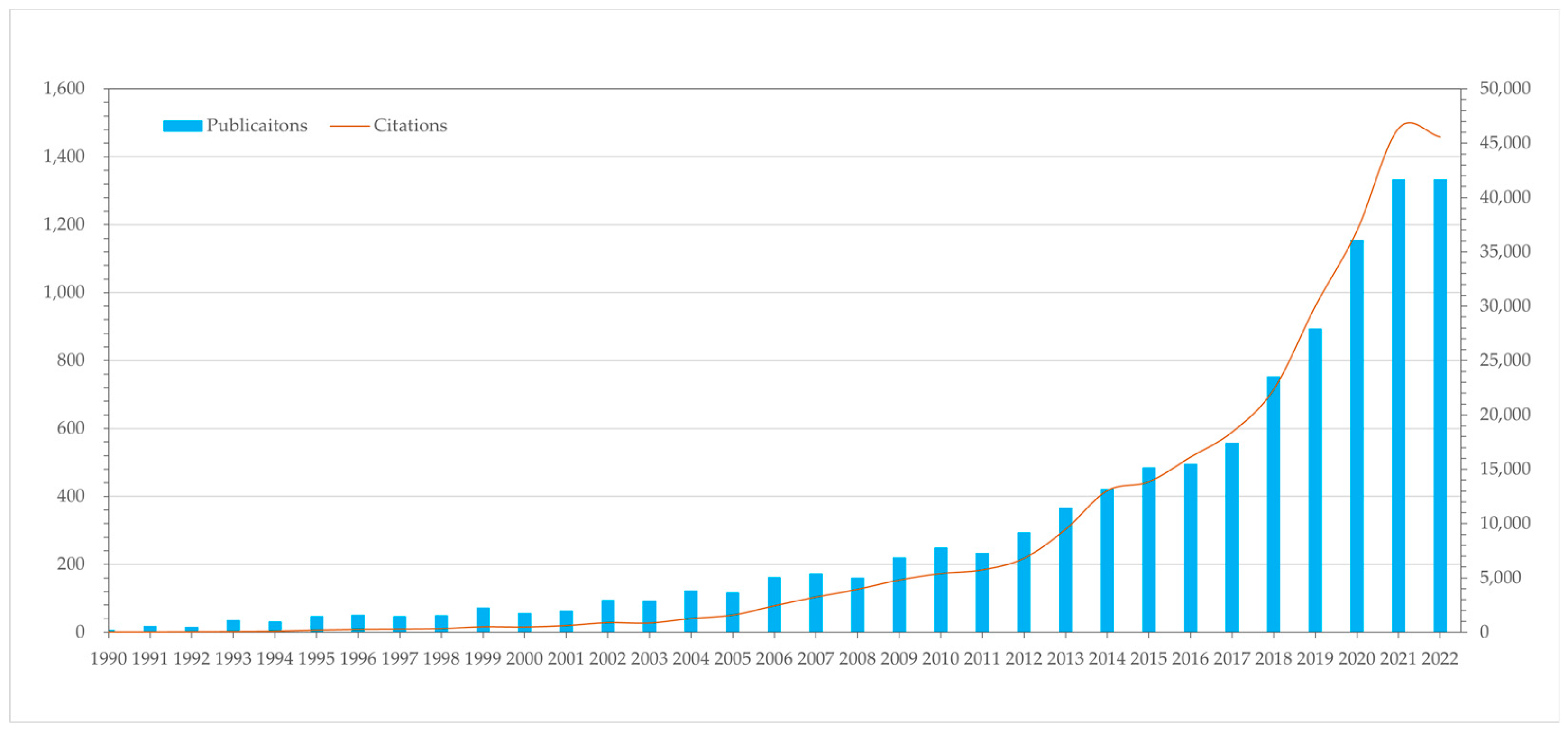
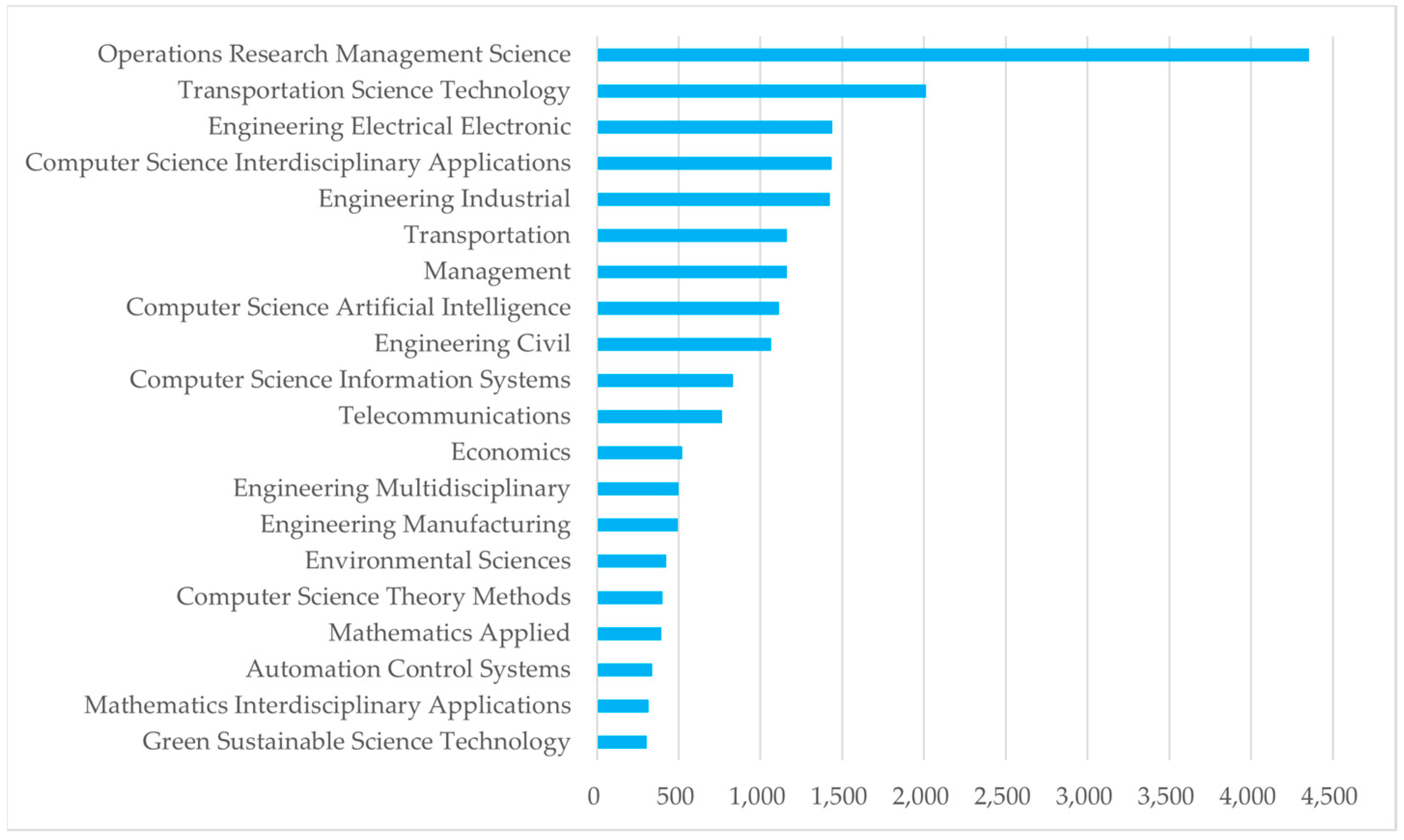
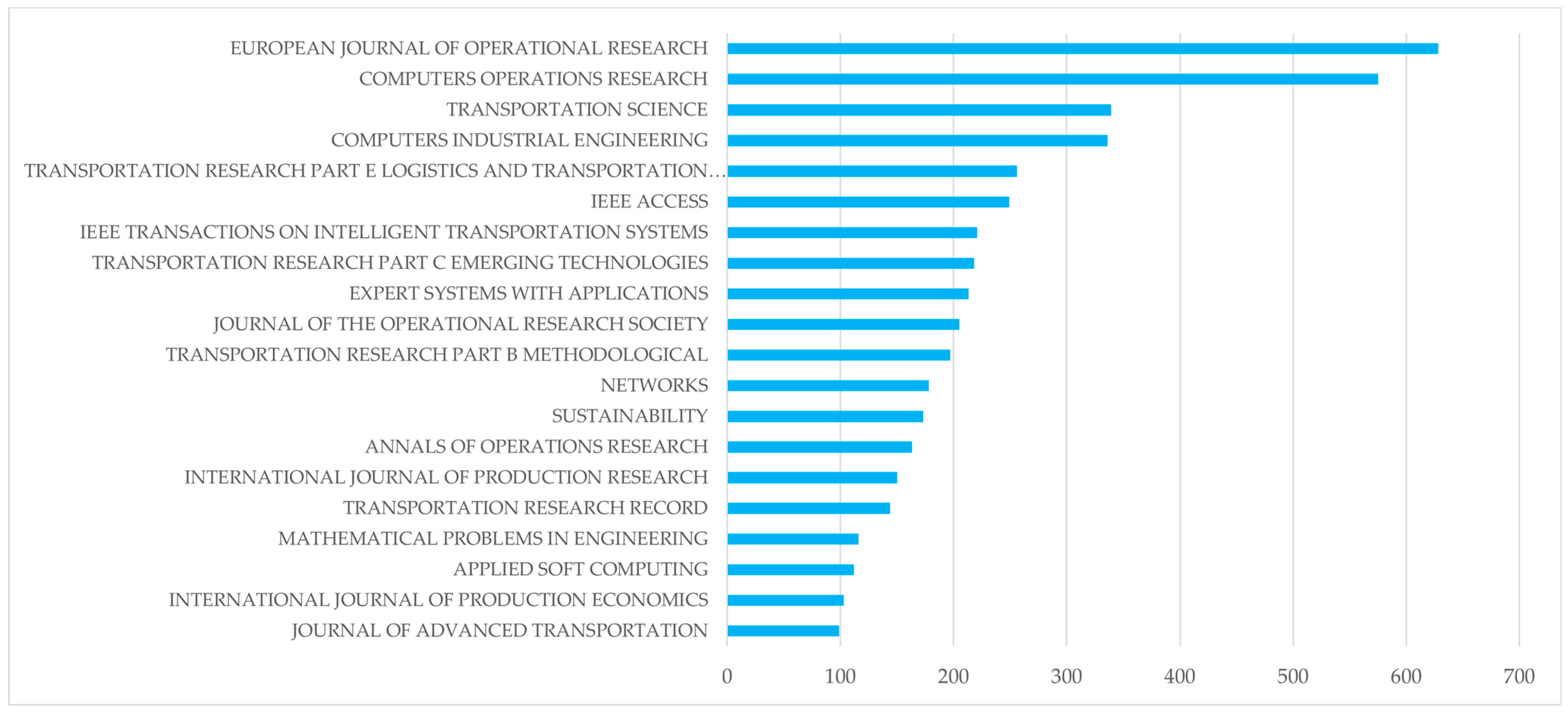
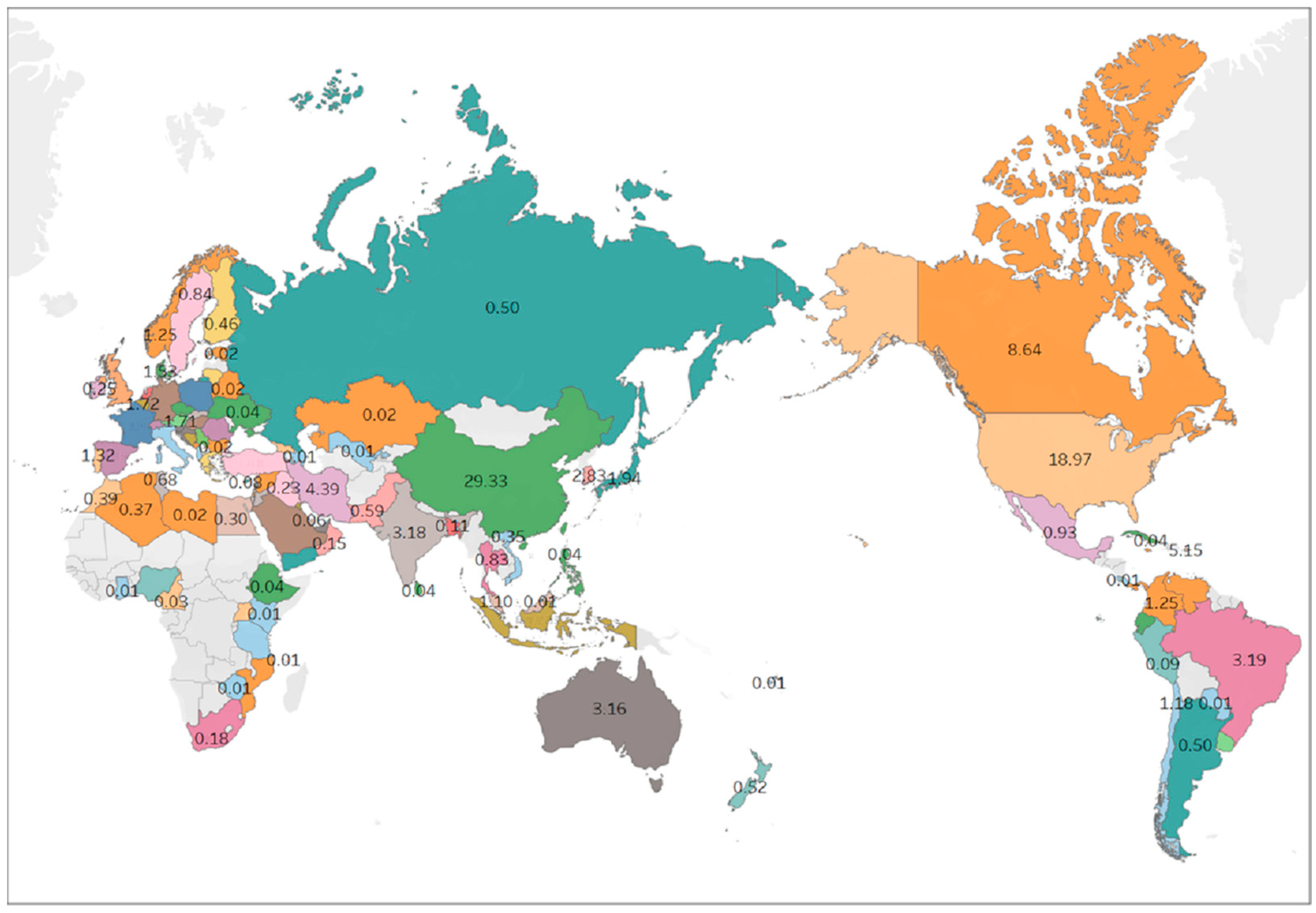
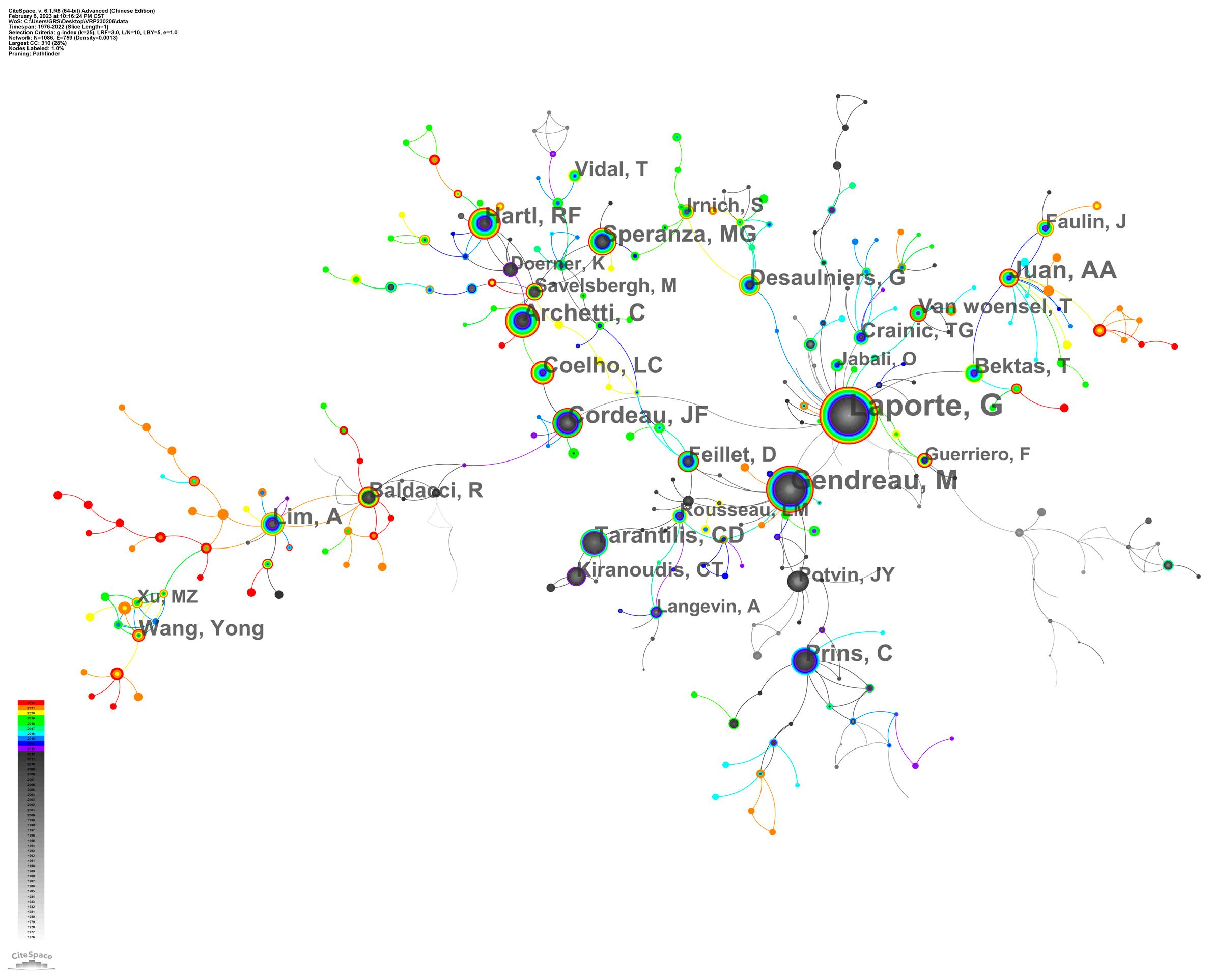
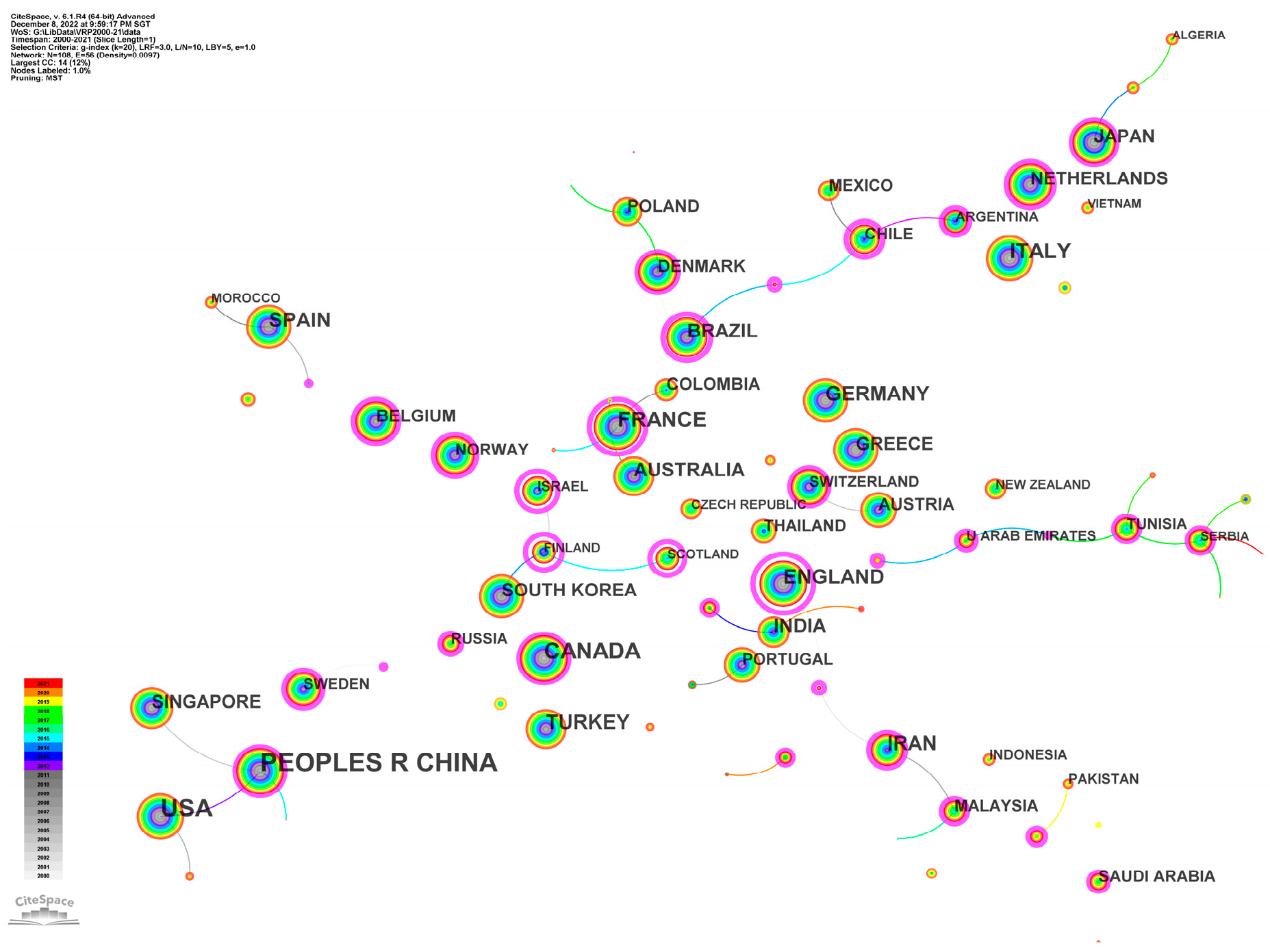
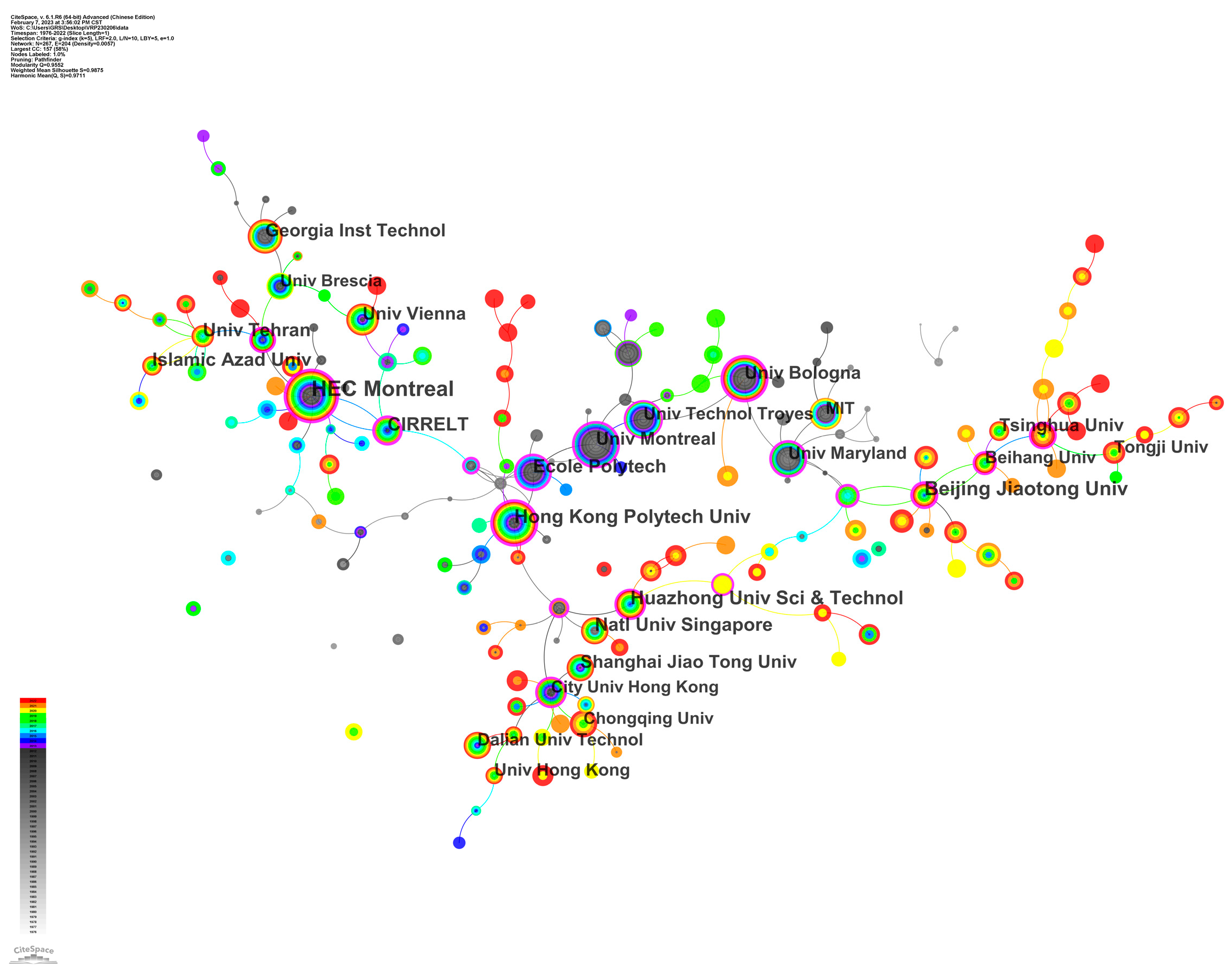
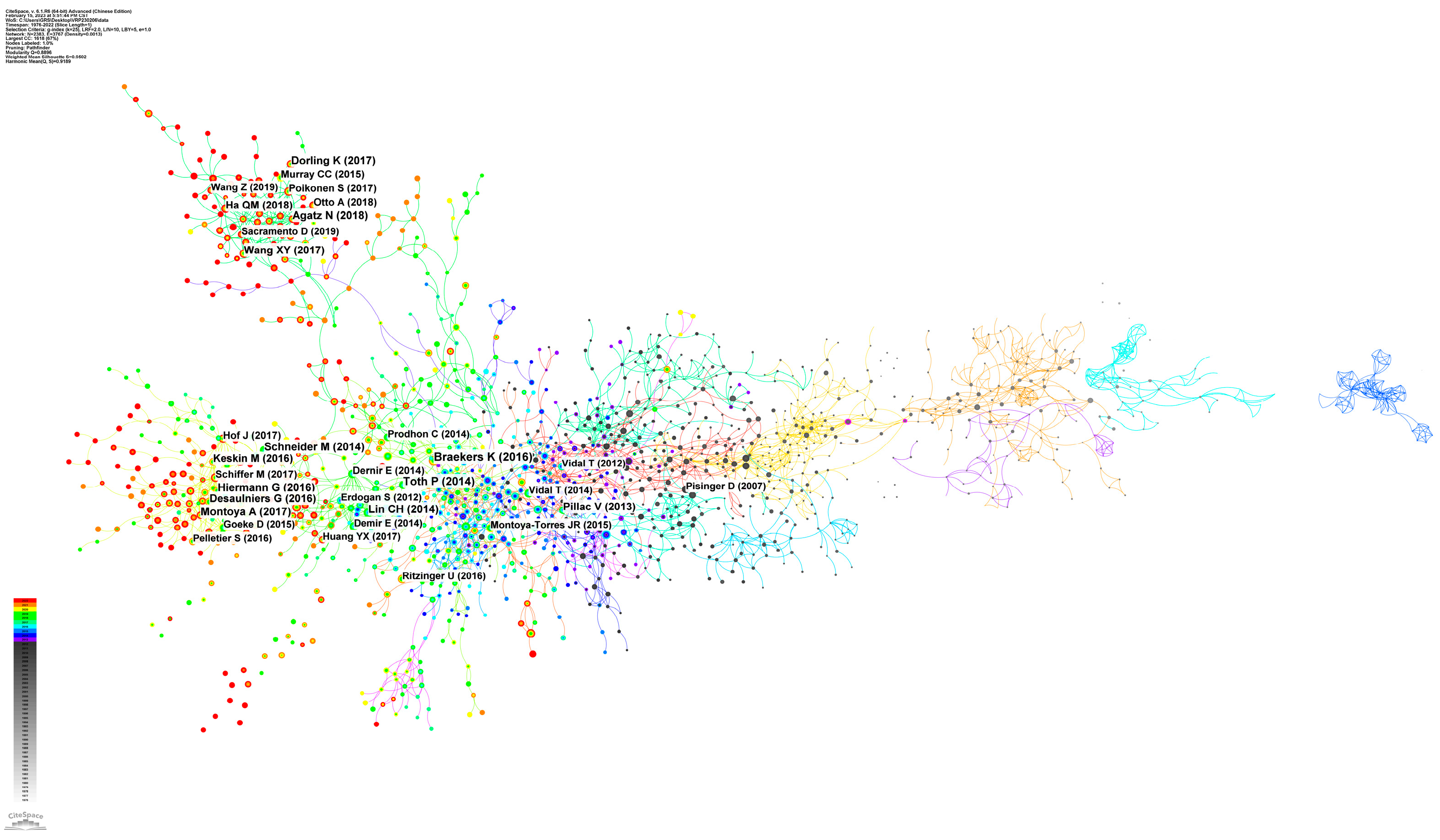
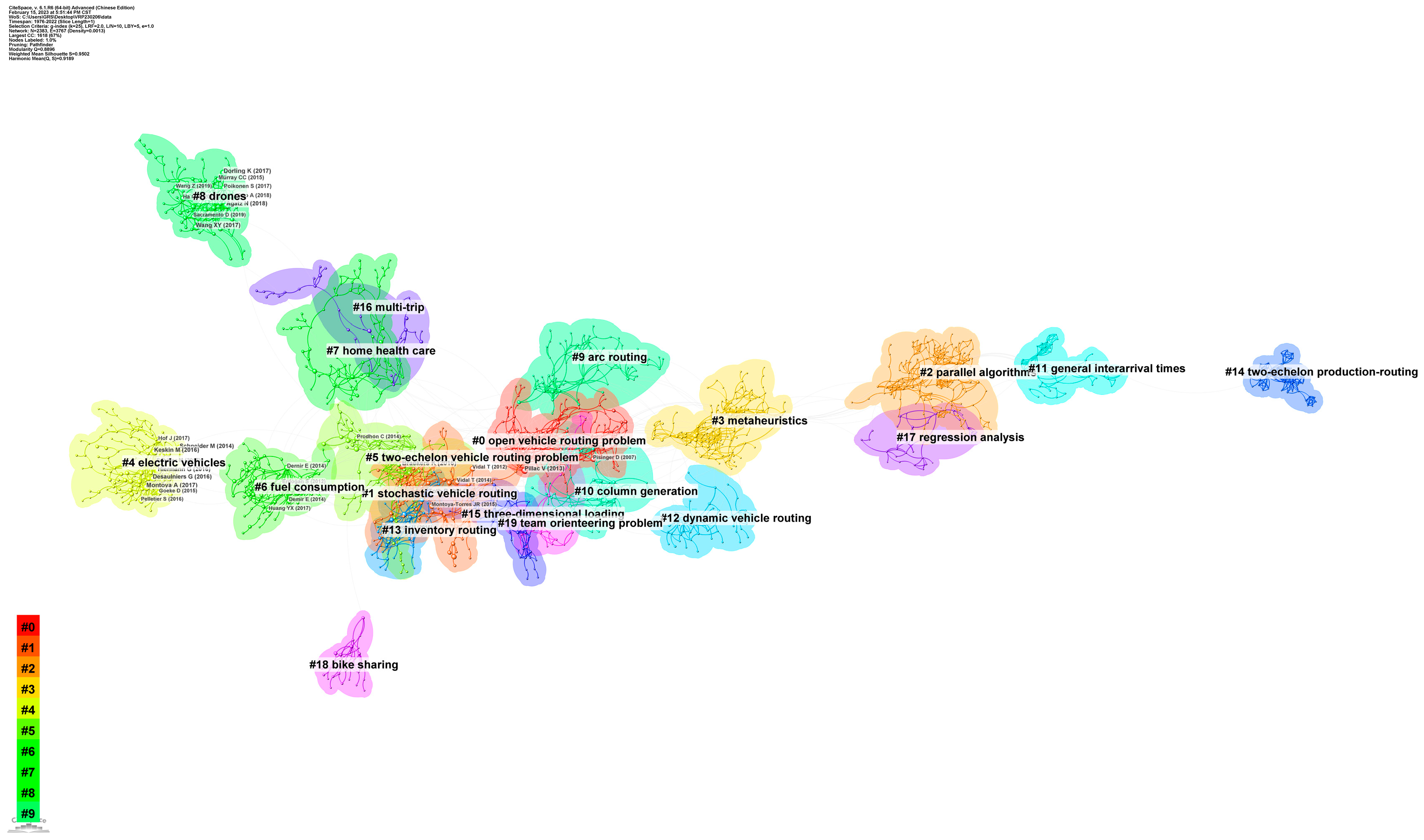
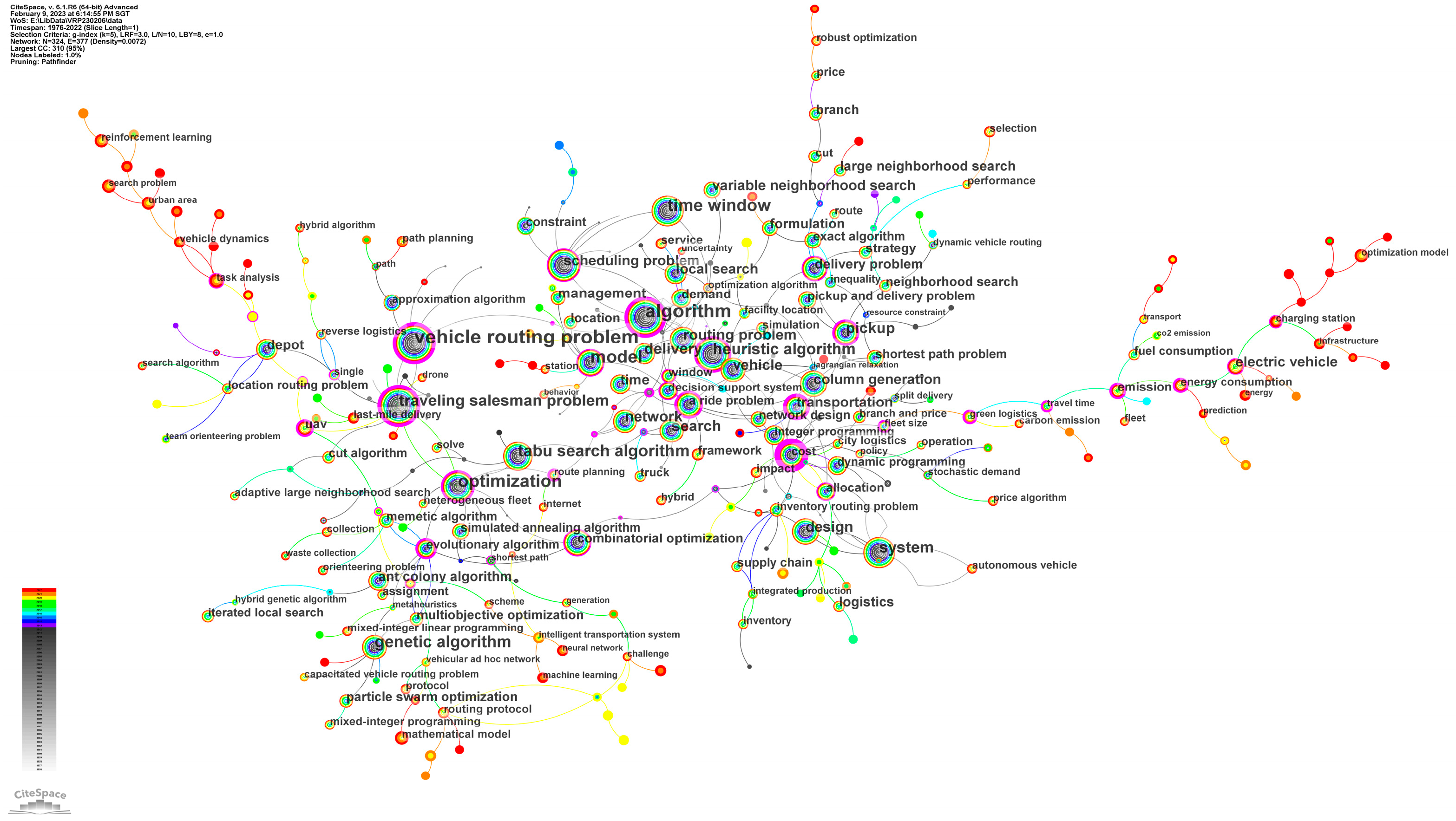
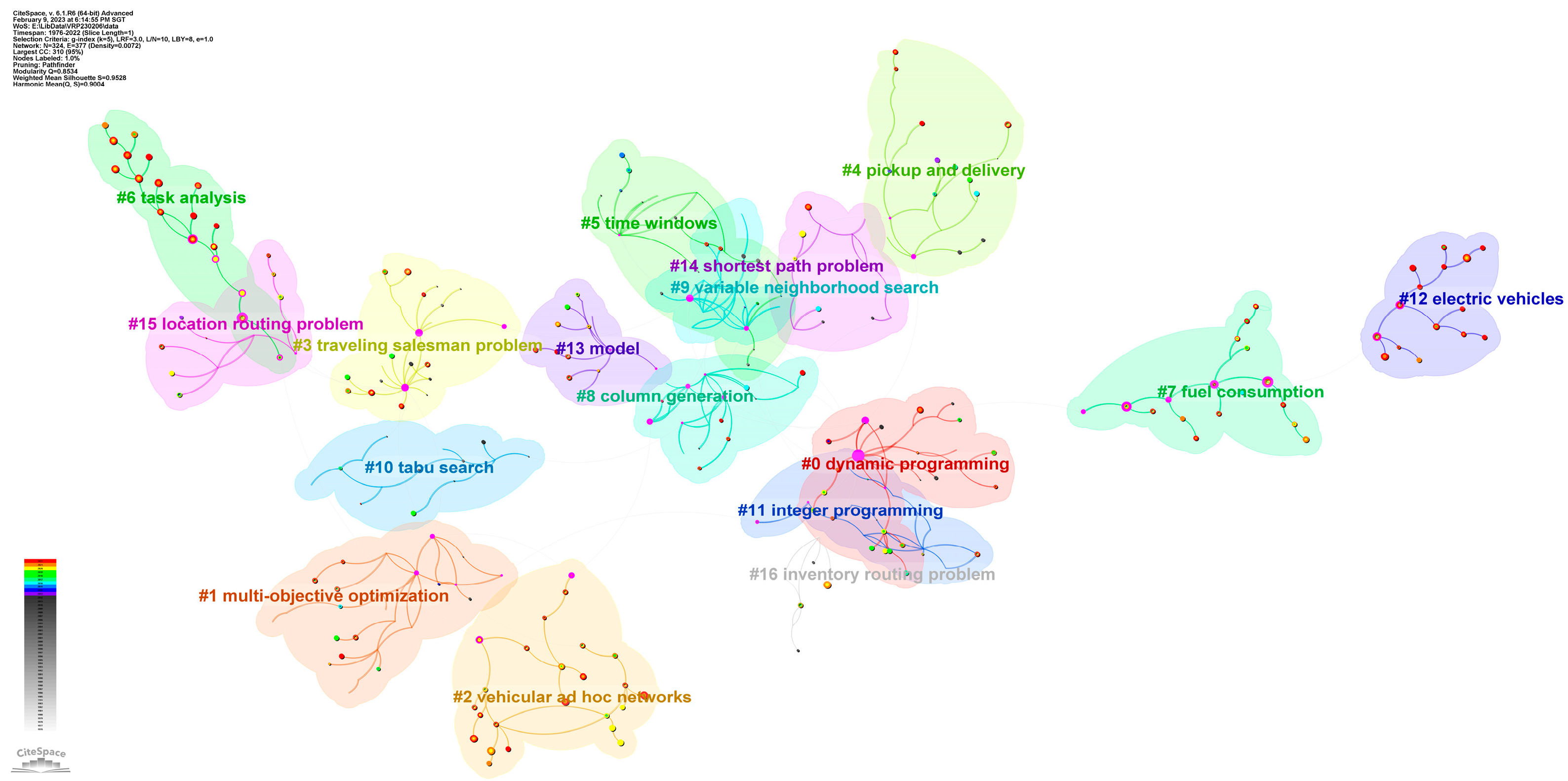
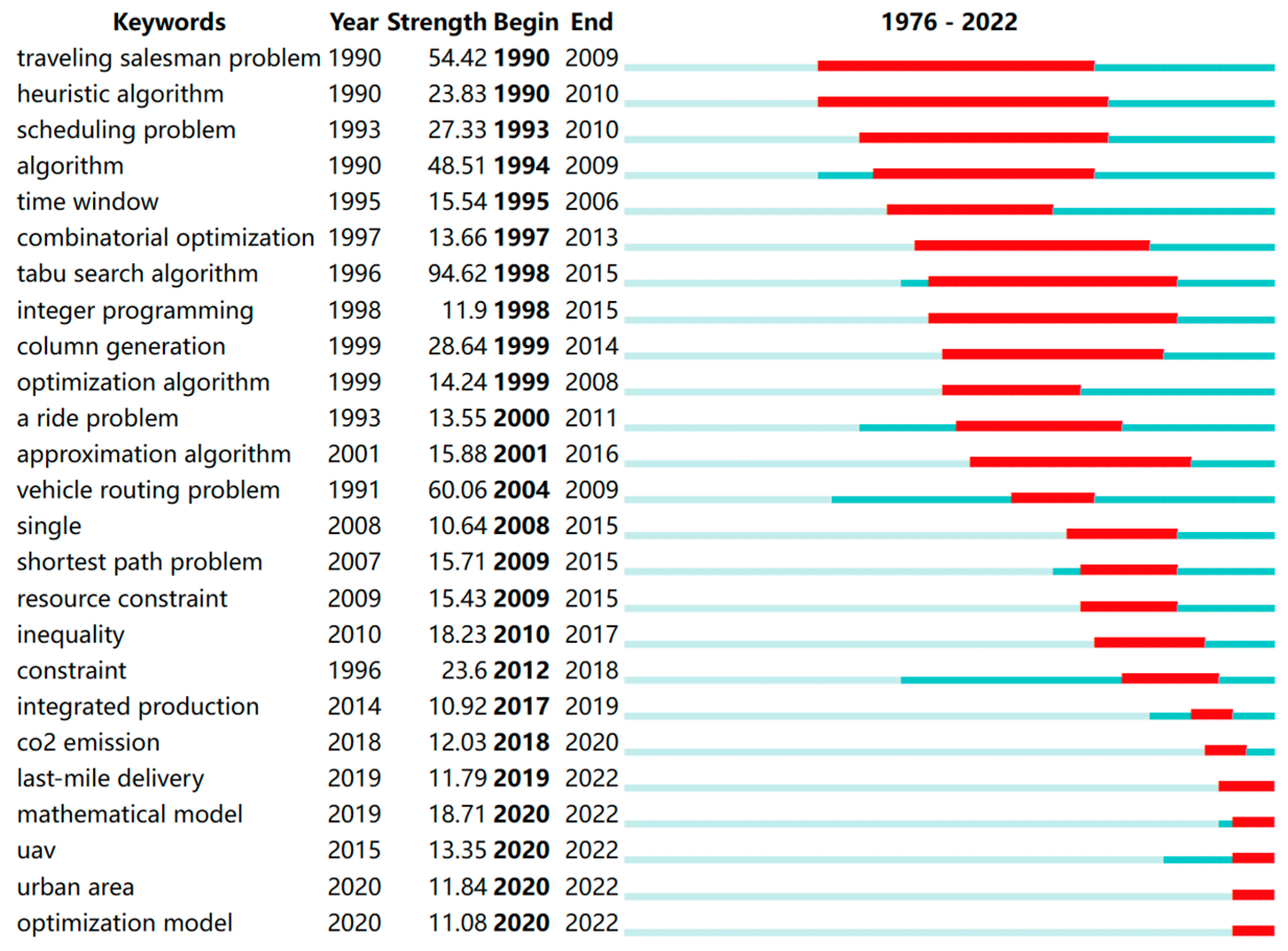
| Type | Number |
|---|---|
| Publications | 10,321 |
| Categories | 144 |
| Authors | 17,618 |
| Countries | 106 |
| Affiliations | 4472 |
| Titles | 1000 |
| Citing articles | 95,622 |
| Time Cited | 205,779 |
| H-index | 202 |
| Categories | USA | China | Canada |
|---|---|---|---|
| ORMS | 893 | 629 | 628 |
| TST | 650 | 563 | 209 |
| EEE | 264 | 623 | 73 |
| Publication Titles | Counts | % of Countries Contribution | ||||
|---|---|---|---|---|---|---|
| EJOR | 629 | Canada—16.06 | Germany—14.94 | USA—13.99 | France—11.76 | China—10.02 |
| COR | 575 | Canada—20.87 | USA—12.86 | Italy—11.48 | France—10.96 | Brazil—10.09 |
| TS | 339 | USA—34.81 | Canada—23.01 | Italy—16.81 | Germany—15.04 | Netherlands—10.32 |
| CIE | 336 | China—23.51 | USA—17.56 | Iran—10.71 | S Korea—8.33 | Turkey—8.04 |
| TRE | 219 | China—35.55 | USA—24.61 | Canada—10.16 | France—6.64 | England—5.86 |
| Rank | Authors | Publications | Times Cited | H-Index | |
|---|---|---|---|---|---|
| Total | Average per Term | ||||
| 1 | Laporte, G | 202 | 16,979 | 87.50 | 72 |
| 2 | Gendreau, M | 115 | 10,536 | 94.24 | 51 |
| 3 | Wang, Y | 78 | 1121 | 16.51 | 20 |
| 4 | Juan, AA | 74 | 1576 | 27.61 | 29 |
| 5 | Cordeau, JF | 65 | 7930 | 124.15 | 39 |
| 6 | Speranza, MG | 61 | 2918 | 49.82 | 32 |
| 7 | Archetti, C | 58 | 2333 | 42.19 | 28 |
| 8 | Hartl, RF | 56 | 3302 | 60.52 | 29 |
| 9 | TarantiliS, CD | 54 | 2179 | 43.13 | 32 |
| 10 | Tavakkoli, R | 53 | 1357 | 26.68 | 20 |
| ID | Size | S | Label (LLR) | Top Items | Average Year |
|---|---|---|---|---|---|
| 0 | 147 | 0.871 | Open vehicle routing problem | Open vehicle; capacitated vehicle; mix vehicle; routing problem; electric vehicle | 2006 |
| 1 | 137 | 0.923 | Stochastic vehicle routing | Stochastic demand; robust vehicle; routing problem; local search; electric vehicle | 2011 |
| 2 | 132 | 0.959 | Parallel algorithm | Parallel evolutionary algorithm; tabu search heuristic; parallel tabu search; bi-objective vehicle; planning model | 1995 |
| 3 | 128 | 0.919 | Metaheuristic | Iterated local search algorithm; efficient metaheuristic algorithm; collecting vehicle; routing product; dehydration plant | 2001 |
| 4 | 118 | 0.984 | Electric vehicles | Electric vehicle; partial recharge; electric bus; mixed charging rate; ambient temperature | 2017 |
| 5 | 98 | 0.953 | Two-echelon VRP | Capacitated location-routing problem; two-echelon capacitated vehicle; two-echelon vehicle; consistent vehicle; location-routing problem | 2012 |
| 6 | 97 | 0.966 | Fuel consumption | Green vehicle; cold chain logistics; urban area; fuel consumption; pollution routing problem | 2015 |
| 7 | 92 | 0.921 | Home healthcare | Home health care; resource sharing; routing problem; strategic oscillation; transportation resource sharing | 2015 |
| 8 | 85 | 0.998 | Drones | Multiple drone; traveling salesman problem; routing problem; last-mile delivery; parcel delivery | 2018 |
| 9 | 80 | 0.976 | Arc routing | Capacitated arc; split delivery vehicle; lean production system; annotated bibliography; recent result | 2005 |
| 10 | 73 | 0.926 | Column generation | Dial-a-ride problem; dynamic transportation; pooling problem; introducing heterogeneous user; adaptive insertion algorithm | 2006 |
| 11 | 53 | 0.973 | General interarrival times | Euclidean plane; dynamic vehicle-routing problem; new generation; robust algorithm; addressing uncertainty | 1991 |
| 12 | 50 | 0.958 | Dynamic vehicle routing | Dynamic pickup; dynamic vehicle; hybrid adaptive predictive control; delivery problem; waiting strategies | 2002 |
| 13 | 46 | 0.960 | Inventory routing | Inventory-routing problem; benders decomposition; vendor-managed inventory; reverse logistics; stochastic inventory-routing | 2012 |
| 14 | 45 | 0.988 | Two-echelon production routing | Asymmetrical capacitated vehicle-routing problem; distance-constrained vehicle-routing problem; capacitated vehicle-routing problem; exact algorithm; combined vehicle-routing | 1981 |
| 15 | 44 | 0.950 | Three-dimensional loading | Multiple stack; loading constraint; traveling salesman problem; double traveling salesman problem | 2010 |
| 16 | 36 | 0.964 | Multi-trip | Release date; same-day delivery; multiple trip; community logistics; stochastic dynamic vehicle | 2015 |
| 17 | 33 | 0.980 | Regression analysis | Stochastic customer demand; probabilistic analyses; central inventories; vehicle-routing cost; two-echelon distribution system | 1994 |
| 18 | 27 | 1.000 | Bike sharing | Rebalancing problem; bike-sharing system; bike sharing; repositioning problem; multiple vehicle | 2015 |
| 19 | 25 | 0.979 | Team orienteering problem | Orienteering problem; solving tourist trip design problem; capacitated team; algorithmic approaches; LP-based granular variable neighborhood search | 2010 |
| 20 | 22 | 0.983 | Occasional drivers | Occasional driver; delivery option; last-mile vehicle; collaborative urban transportation; crowd-shipping setting | 2017 |
| 22 | 17 | 1.000 | Route construction and improvement | Vehicle-routing; algorithm; scheduling problem; routing problem; electric vehicle | 1982 |
| 26 | 14 | 0.998 | Lagrangian relaxation for delivery problems | Capacitated vehicle-routing; unique item; multi-stop multiterminal delivery route; parallel saving; vehicle-routing problem | 1988 |
| 31 | 8 | 0.987 | Perishable products | Perishable product; robust bi-objective model; sustainable inventory; two-echelon inventory; cold-chain inventory | 2016 |
| 39 | 6 | 0.992 | Constraint programming environment | Constraint programming environment; global search; learning hybrid algorithm; single vehicle pickup; tabu search heuristic | 1997 |
| 43 | 5 | 1.000 | Branch and cut | Cut; parallel branch; capacitated vehicle; routing problem; electric vehicle | 1998 |
| Cluster ID | Citation Counts | Reference |
|---|---|---|
| 1 | 203 | Braekers K, 2016, COMPUT IND ENG, V99, P300 [31] |
| 15 | 163 | Toth P, 2014, MOS-SIAM SER OPTIMIZ, V0, P1 [32] |
| 8 | 158 | Dorling K, 2017, IEEE T SYST MAN CY-S, V47, P70 [34] |
| 4 | 153 | Montoya A, 2017, TRANSPORT RES B-METH, V103, P87 [36] |
| 6 | 150 | Lin CH, 2014, EXPERT SYST APPL, V41, P1118 [40] |
| 4 | 146 | Hiermann G, 2016, EUR J OPER RES, V252, P995 [37] |
| 4 | 140 | Schneider M, 2014, TRANSPORT SCI, V48, P500 [38] |
| 8 | 139 | Agatz N, 2018, TRANSPORT SCI, V52, P965 [33] |
| 8 | 125 | Wang XY, 2017, OPTIM LETT, V11, P679 [35] |
| 4 | 124 | Desaulniers G, 2016, OPER RES, V64, P1388 [39] |
Disclaimer/Publisher’s Note: The statements, opinions and data contained in all publications are solely those of the individual author(s) and contributor(s) and not of MDPI and/or the editor(s). MDPI and/or the editor(s) disclaim responsibility for any injury to people or property resulting from any ideas, methods, instructions or products referred to in the content. |
© 2023 by the authors. Licensee MDPI, Basel, Switzerland. This article is an open access article distributed under the terms and conditions of the Creative Commons Attribution (CC BY) license (https://creativecommons.org/licenses/by/4.0/).
Share and Cite
Ni, Q.; Tang, Y. A Bibliometric Visualized Analysis and Classification of Vehicle Routing Problem Research. Sustainability 2023, 15, 7394. https://doi.org/10.3390/su15097394
Ni Q, Tang Y. A Bibliometric Visualized Analysis and Classification of Vehicle Routing Problem Research. Sustainability. 2023; 15(9):7394. https://doi.org/10.3390/su15097394
Chicago/Turabian StyleNi, Qiuping, and Yuanxiang Tang. 2023. "A Bibliometric Visualized Analysis and Classification of Vehicle Routing Problem Research" Sustainability 15, no. 9: 7394. https://doi.org/10.3390/su15097394
APA StyleNi, Q., & Tang, Y. (2023). A Bibliometric Visualized Analysis and Classification of Vehicle Routing Problem Research. Sustainability, 15(9), 7394. https://doi.org/10.3390/su15097394







